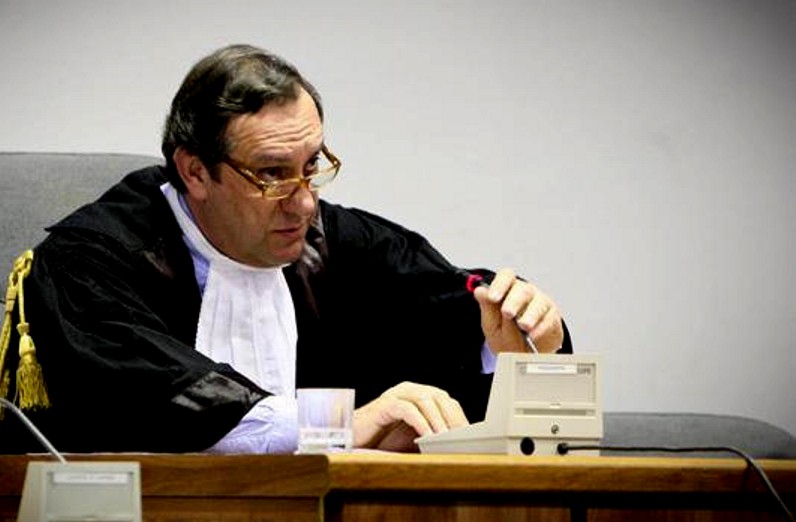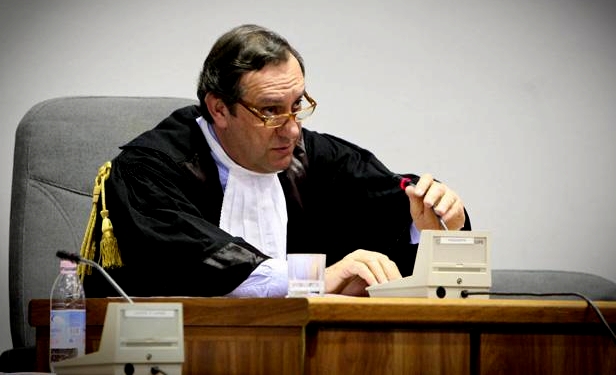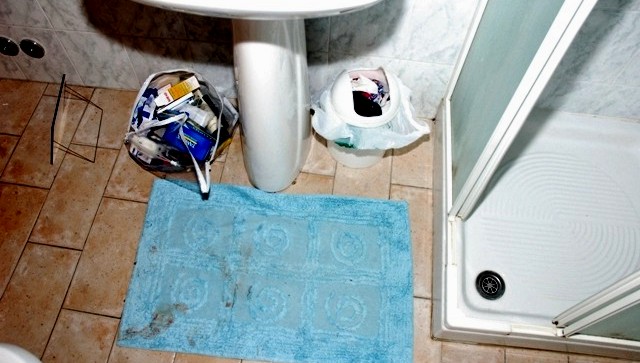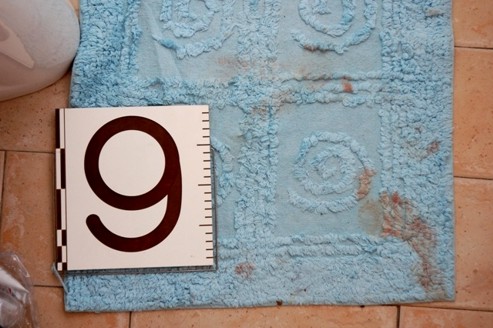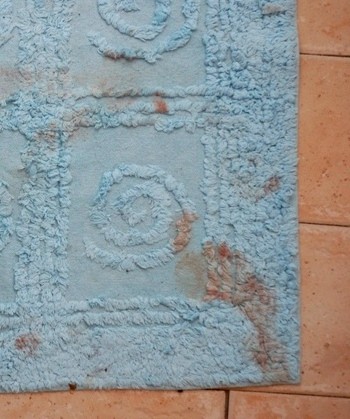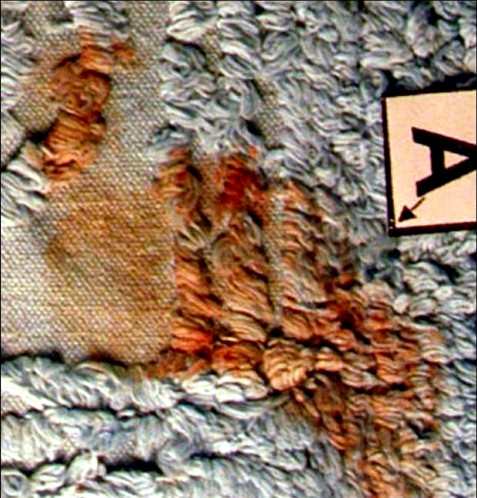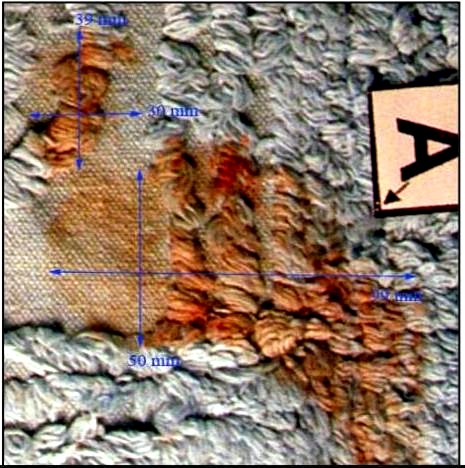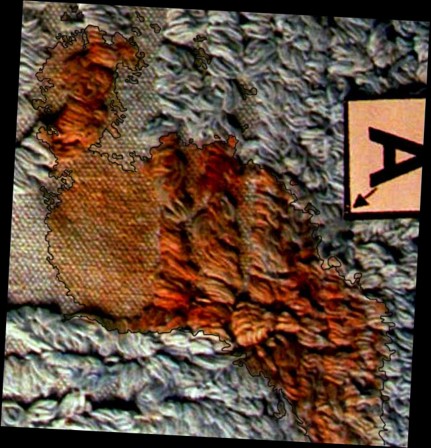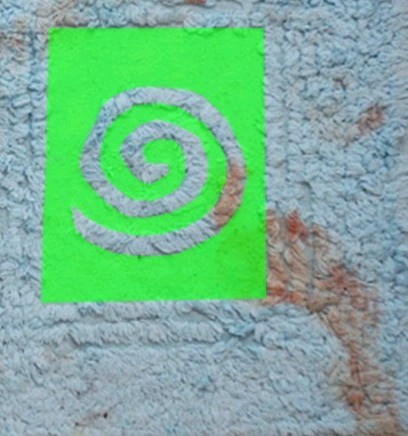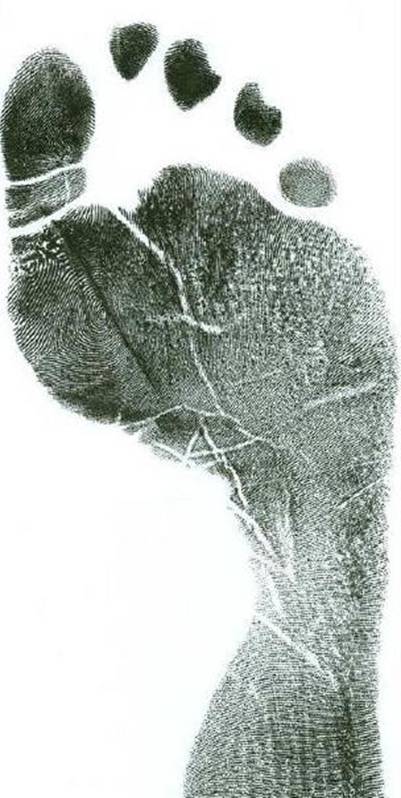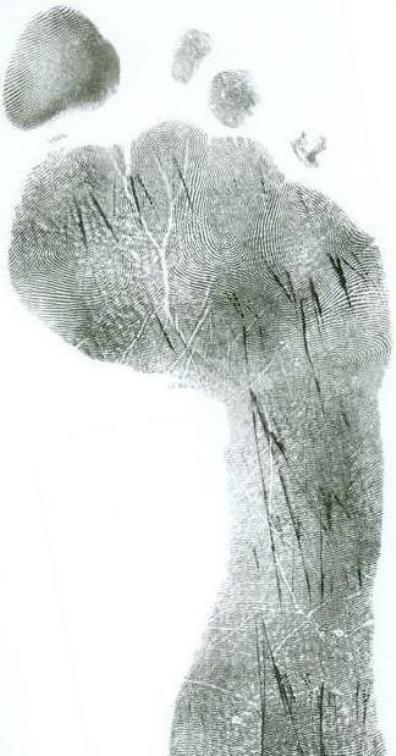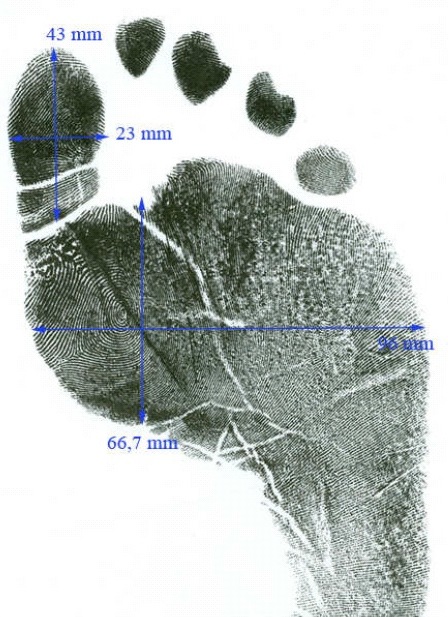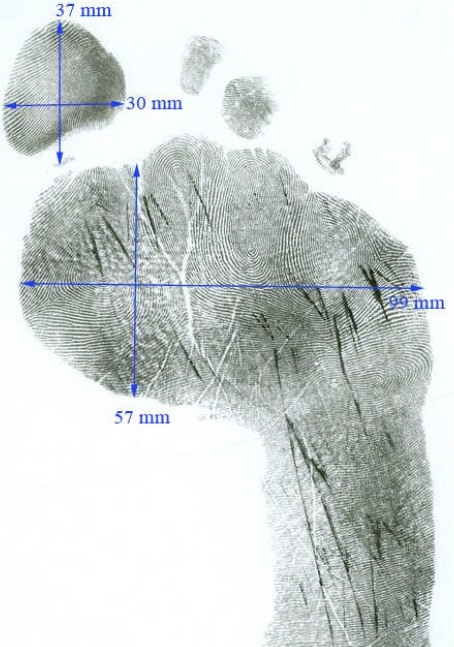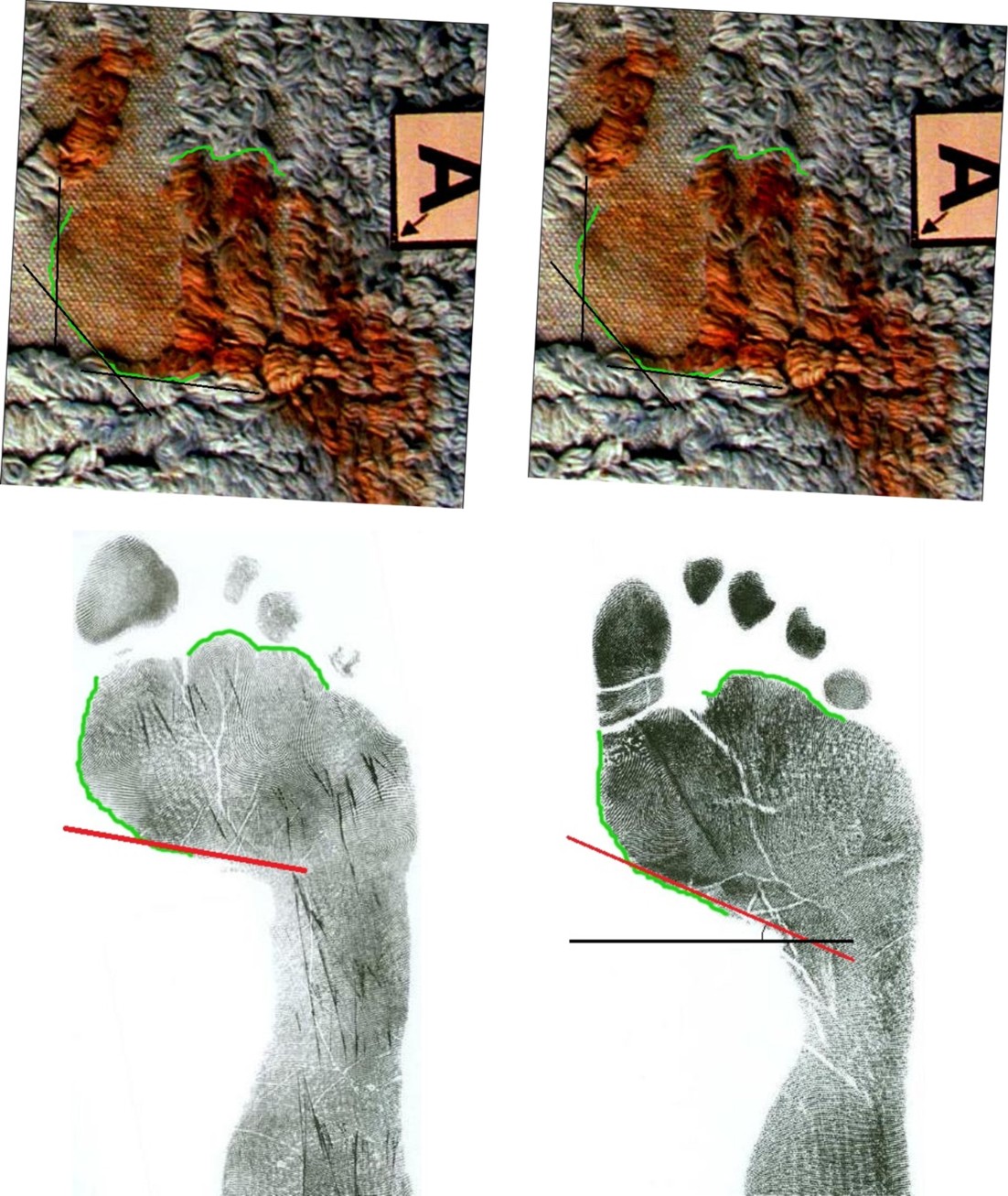
Headsup: Disney's Hulu - mafia tool?! First warning already sent to the Knox series production team about the hoaxes and mafia connections. The Daily Beast's badly duped Grace Harrington calls it "the true story of Knox’s wrongful conviction of the murder of her roommate". Harrington should google "rocco sollecito" for why Italians hesitate to talk freely.
Sunday, May 11, 2014
Knox Interrogation Hoax #1: Masterlist Of Posts Re Pre-Trial Events And Hoax Overview
Posted by Our Main Posters

Perugia Central Police Station at night (left-center)
1. Masterlist Of Posts In The Series
The Interrogation Hoax series will consist of a total of 24 posts.
These posts quote from a large number of transcripts only recently acquired and translated. There are no serious conflicts, no gray areas. One can assume with total certainty that this is the real thing (see Part 3 below), and that any other versions (see Part 4 below) are fabricated.
Numbering of posts 1-24 is not chronological, it represents the original order of postings.
1. What Happened At AK & RS Q&A Prior To 6 Nov
Click for Post: #19: ALL Knox Q&A Sessions 2-6 November 2007 WERE Recorded #1
Click for Post: #20: ALL Knox Q&A Sessions 2-6 November 2007 WERE Recorded #2
2. What Happened At Knox Q&A 6 Nov Ending 1:45 AM
Click for Post: #2: Trial Testimony From Rita Ficcara On Realities 5-6 Nov
Click for Post: #3: More Defense Pussyfooting Toward Rita Ficcara, Key Witness
Click for Post: #4: More Hard Realities From Rita Ficcara, More Nervousness From Defense
Click for Post: #12: Ficarra & Knox Notes PROVE Knox Merely Worked On Visitors Names List
Click for Post: #5: Key Witness Monica Napoleoni Confirms Knox Self-Imploded 5-6 Nov
Click for Post: #7: Testimony Of Witness Lorena Zugarini On The Knox Conniption 5-6 Nov
Click for Post: #8: Testimony Of Interpreter Donnino On Events Night Of 5 November
3. What Happened At Sollecito Q&A 6 Nov Ending 3:30 AM
Click for Post: #6: Sollecito Transcript & Actions Further Damage Knox Version
Click for Post: #9: Officer Moscatelli’s Recap/Summary Session With Sollecito 5-6 Nov
4. What Happened At Knox-Rights Session Ending 5:45am
Click for Post: #15: Knox Is Told Her Rights And Repeats Fake Murder Charge
5. What Of Relevance Happened In Ensuing Months
Click for Post: #13: The First Two Pre-Trial Opportunities Which Knox Flunked
Click for Post: #14: The Third Pre-Trial Opportunitty Which Knox Flunked
Click for Post: #16: The Fourth Pre-Trial Opportunity Which Knox Flunked
Click for Post: #17: Sollecito April 2008 Before Supreme Court Again Coldshoulders Knox
Click for Post:#18: The Final Pre-Trial Opportunities Which Knox Flunked
Click for Post: #21: Illustrating How Batshit Crazy The Interrogation Hoax Has Become
6. Why Investigators’ Version Won Hands-Down At Trial
Click for Post: #10: Why Prosecution And Defenses Never Believed Knox’s Version #1
Click for Post: #11: Why Prosecution And Defenses Never Believed Knox’s Version #2
2. Explaining Overall Arc Of Events
Much of the testimony listed above was about events at the central police station pre-arrest in early November 2007 and subsequent court attempts to achieve some believability and relief.
Early in 2009 at trial Knox and Sollecito sat glumly through all of the investigators’ pre-arrest testimony and cross-examination at trial. They were downhearted and apprehensive, and there were no smiles and few interruptions.
Subsequently Sollecito chose not to get on the stand, so from his team there really was never a rebuttal.
But Knox HAD to get on the stand, in July, for two days. She had no other way to defend herself against the serious felony crime of falsely framing Patrick for murder.
It was her word against theirs. It contradicted in many places what she had heard months earlier in sworn testimony from many investigators.
Knox’s version inevitably weakened a lot under cross-examination, and was ultimately a fail at trial and several appeals, even the annulled one.
Knox ended up serving three years. While on the stand she confirmed that she had been treated well, stiffing thousands of supporters duped into believing she had not been.
3. Explaining Court-Accepted Narrative For 6 Nov
This is an overview of Knox’s so-called “interrogation” at Perugia’s central police station, the subject of the first ten posts.
It led to her arrest and three years served. To make this picture really firm we will quote a lot of the testimony at trial. The Case Wiki carries all of these transcripts, many in English translation, and more.
Senior Inspector Rita Ficarra testified that she arrived back at the police station late on 5 November, and finds her way blocked by a cartwheeling Knox.
She rebukes Knox, who testily responds that she is tired of the investigation. Rita Ficarra tells Knox to go home and get some sleep. Knox testily refuses, and remains there.
Shortly after, Ficarra suggests to Knox that if she really wants to help, she could add to the list of possible perps - men who Meredith knew and who might have visited the house.
This was a recap/summary, a simple checking of facts with someone who might or might not be of help. This could have been done on a street corner or in a house by a single officer. It was not a witness or suspect interrogation. From the transcript:
Ghirga: “While this interrogation - let’s call it thus - was in progress, some colleagues arrive…” Ficarra: “It was not an interrogation, Attorney.” Ghirga: “They are called recaps/summaries.
Knox eagerly agrees. So they begin on the list.
This goes slowly because of language problems, until an interpreter, Anna Donnino, arrives. In total only Knox and four others (three of them women) are present.
Knox builds a list of seven people and adds maps and phone numbers (placed in evidence) in a calm proceeding. These were the names: Peter Svizzero, Patrick, Ardak, Juve, Spiros, Shaki and “a South African [Guede]” who played basketball near the house.
At several points in the evening Knox is provided with refreshments. No voices are ever raised, no bathroom breaks are refused.
In a separate wing Inspector Napoleoni and a couple of colleagues are seeking facts from Sollecito. Shown conflicts between what he has said and what his phone records show, Sollecito backtracks, and declares that Knox went out alone on the night, and made him lie.
Napoleoni moves through the questura to suggest to Ficarra to discuss the night of the attack with Knox in more detail and clarify who might have been present. Knox is not informed of Sollecito’s backtrack. She is asked for more names and spontaneously shares her phone. There is an outgoing to Patrick but no prior incoming. Knox is asked who Patrick is.
Suddenly, to the considerable surprise of others present, Knox has a yelling, head-clutching conniption (the first of several that night) and says “It’s him, it’s him, it was him, he killed her”. The session is halted.
Despite warnings she should not do so without a lawyer, Knox insists on a recorded statement which says she headed out to meet Patrick that night after he texted her. She accuses Patrick of killing Meredith.
Efforts are made throughout the next several hours to try to help Knox to calm down. Knox is put on hold, given more refreshments, and made comfortable on some chairs so she might try to get some sleep.
A second session ending at 5:45 is intended as merely a formal reading of Knox’s legal status and her right to a lawyer, with Dr Mignini presiding. She is to be held as a material witness and for her own protection.
Again warned that she should not speak without a lawyer, and no questions can be asked, Knox still insists on a second spontaneous accusation culminating in a second recorded statement.
This also says she went out to meet Patrick that night, also accuses Patrick of killing Meredith, and now also hints that Sollecito may have been there.
Just before noon, now under arrest and about to be taken to Capanne Prison, Knox insists on writing out at length a third statement this time in English.
She gleefully hands it to Rita Ficcara who cannot read it as she as no English. In the statement, Knox included this damning remark, without any mention of having been coerced: “The questions that need answering, at least for how I’m thinking are… 2. Why did I think of Patrik?”
Knox’s lawyers never ever substantially challenge this version, and never lodge any complaint. At trial in 2009 they accept on the record that there was no interrogation, and leave standing that Knox insisted on all three statements, and dont ever pursue Knox’s claims that she was coerced.
Courts all noted that there is no mention in that third note of Knox having been coerced, although this note was her idea and she could put in it anything she liked. From this there never was any going back.
In July 2009 at trial, in face of days and days of prior investigator testimony, Knox brashly tried to substitute this scenario above with the one below. Of course she was disbelieved.
For the calunnia framing of Patrick Lumumba Judge Massei in 2009 sentenced her to a year more than Sollecito, amended by Judge Hellmann in 2011 to three years served.
The Supreme Court definitively overruled her calunnia appeal so for her false framing of Patrick she is a felon for life.
4. Explaining Knox Family & PR Alternative
Knox’s Italian lawyers were not a part of this; in contrast the American PR lawyer Ted Simon sought to introduce major confusion.
In Italy, lawyers are REQUIRED to report tales of abuse of their clients or face possible criminal charges. Contrariwise, if they knowingly report false charges they can face similar charges. So what they do is a strong indicator of truth.
Amanda Knox’s lawyers not only did not ever report any abuse. They even announced publicly, in face of incessant claims of abuse by Knox, family, and PR forces, that they had seen no evidence of abuse and so would not be reporting.
Though her precise claims vary and often contradict one another, Knox herself has on and off ever since November 2007 tried to put the investigators on trial - tried to blame the police for causing her conniption and her false accusation of Patrick for the death of Meredith.
Her fail rate has been spectacular.
Knox failed to convince (1) Supervising Magistrate Matteini and (2) the Ricciarelli review panel in November 2007, (3) failed to convince Prosecutor Mignini in December 2007, (4) failed to convince the Supreme Court in April 2008, (5) failed to convince the Micheli court in late 2008, (6) failed to convince the judges and jury at trial 2009, (7) failed at annulled appeal 2011, (8) failed at repeat appeal 2013, (9) failed to convince the Supreme Court in 2012 and (10) failed again in 2015.
As Knox’s team simply did not ever believe her, they may not have given this their hardest shot. It was not part of their largely spurious complaint to the EC HR.
And yet despite all of these failures, the huge and very nasty Knox PR effort went full-bore ahead with the abuse allegations anyway.
Read this post of 11 February 2009 which was about two weeks before the Knox “interrogators” were cross-examined at trial, and several months before Knox herself took the stand. Dozens of media reports repeated the Knox claims as if true.
Knox repeated them in her April 2013 book, and her December 2013 email to Judge Nencini, and her appeal to EHCR Strasbourg, and in some TV and newspaper interviews, including one with the Italian weekly Oggi which caused that paper legal harm.
This version has been blown up by Knox PR shills in internet posts, articles, TV interviews, and books. Among others propagating it have been Raffaele Sollecito (in his book), Doug Preston, Saul Kassin, Steve Moore (especially), John Douglas, Jim Clemente, Paul Ciolino, Michael Heavey, Greg Hampikian, Chris Halkidis, Mark Waterbury, Doug Bremner, Candace Dempsey, Nina Burleigh, Bruce Fischer, and many posters on the Knox sites and Fischer sites and on Ground Report.
Main claims included 50-plus hours of “interrogation”, numerous officers in teams, no food or drink, no sleep, no bathroom breaks, no lawyer, no recording, and much abuse and yelling and suggestions and threats. Way beyond anything even Knox herself and notably her own lawyers ever claimed.
- Here is Steve Moore claiming that around a dozen cops in rotating tag teams of two assaulted a starving and sleepless Knox over 20/30/40 hours, threatened her, and refused her a lawyer throughout.
- Here is Saul Kassin claiming that Knox was interrogated over the entire night of 5-6 November, until she was finally broken and a coerced “confession” emerged - even though the “false confession” actually framed Patrick and was in reality a false accusation. That Kassin ignores.
- Here are several former FBI profilers blatantly embellishing the same claims in a book, with (today) 60 five-star reviews.
And yet Knox’s own Italian lawyers specifically denied her accusations! No complaint against the police was ever lodged. All courts disbelieved her. Knox served her three years. But still the PR-driven hoax keeps resounding.
Friday, May 09, 2014
Amanda Knox’s Awkward, Robotic TV Appearances: New Science Could Blow Away Such Fraud
Posted by Peter Quennell
In Italy the zillion or so Italians that Amanda Knox has framed are starting to push back on steroids in the Italian media and courts.
More on that coming up. Meanwhile Americans have been a tad less nimble to realize that they’ve swallowed a gigantic hoax.
Unsurprising, perhaps, given years of uniquely one-sided TV coverage of the case. But thanks to the good English-language reporters in Italy who have persevered. And thanks to CNN’s Nancy Grace for her biting segment this week, making it quite obvious where she stands on guilt.
Knox’s TV appearances and written statements are ringing more and more hollow as they lose all touch with reality. See our post immediately below. Such a brazen mangling of hard facts is absolutely absurd.
The professionals Vivianna and Friendofstfrank, main posters here, each have posts in the works for us on what they have been reading from Knox’s persona on the TV screen.
In the meantime, please check out these videos on the new science. Each is an hour long. They show just how hard it could get for any future Knoxes and Sollecitos to sustain a similar hoax in future.
Here’s an overview of the videos from the New York Times.
The program looks at how developments in neuroscience are affecting court cases and might do so even more radically in the future. It sets up a fictional trial involving a shooting during a convenience store robbery, cutting between courtroom scenes and visits with researchers and legal scholars who are working on the front edge of this world.
By mapping brain activity, scientists know quite a bit about which regions are involved with processes like facial recognition, as well as the differences between mature adult brains and the brains of young people. (The fictional shooting suspect is 18.) The program has segments on how this research might be applied to issues like determining whether a witness is correctly identifying someone, whether a defendant is lying about not having been at a particular location, even whether potential jurors have racial biases.
Researchers, able to see the implications of their work, are also already studying whether knowledgeable test subjects can subvert the technology, rigging test results by how they think or where they focus their eyes.
Tuesday, May 06, 2014
Judge Nencini Issues Harsh Warning To Tell The Truth - So Amanda Knox Does The Precise Opposite
Posted by Our Main Posters
1. Substance Of The Nencini Explanatory Report
The Florence Court of Appeals released the Nencini Motivations Report in Florence one week ago today.
This report explains the rejection of Knox’s and Sollecito’s own first appeal against the Massei trial outcome of 2009. Four years were lost because the Hellmann court, which heard the first iteration of that appeal was bent as Cassation, the competent judge displaced, and now Judge Nencini have all concluded.
The Hellmann outcome of 2011 was mostly annulled, as in “ceased to exist”. The main findings and verdict have zero legal standing, and zero relevance to today’s process though (see below) Knox and Sollecito repeatedly try to ride that dead horse again.
Cassation confirmed Knox’s three-year prison sentence for framing Patrick (for which she has served the time). And Cassation referred the methods and recommendations of the Conti & Vecchiotti consultancy, which Cassation had hammered on legal grounds, to the Florence appeal court for the substance to be reviewed.
Our evidence and law experts here and in Italy have been looking at Judge Nencini’s 347 page report and find it hard-hitting and unequivocally blunt.
It will be extremely hard to appeal against within the very narrow limits Cassation allows. It removes all of Judge Massei’s ambiguities about motives, it reaffirms the witness statements of Curatolo and Quintavalle, and it judicially affirms the validity of the DNA and other forensic evidence against Knox and Sollecito.
There is overwhelming proof of the presence of all three perps, Knox, Sollecito and Guede, in the cottage that night. Guede is considered to have been brought inside by Knox, who had the only key, and he could not possibly have broken in through Filomena Romanelli’s window in the manner asserted by their defense.
Especially troubling for the defense, the report hints at an illegal suborning of the independent forensic experts appointed by the Hellmann court, and it also hints that the two “supergrass” witnesses, the prisoners Aviello and Alessi, may have been illegally tampered with by Sollecito’s lawyer Giulia Bongiorno, as first claimed 30 months ago.
The report warns that criminal slander of justice officials and other contempts of court will be heavily leaned on.
So the report demolishes the last remnants of Judge Claudio Hellmann’s now annulled acquittal, and substitutes for its fatally flawed reasoning a tightly crafted report that confirms the convictions of Knox and Sollecito.
It confirms that they acted in concert with Guede as Cassation itself long ago concluded had to be the case, and it appears to close any possible argument against the verdict that will carry weight at the Supreme Court.
2. Amanda Knox’s Press-Release Statement In Response
Knox issued a seven paragraph statement later the same day. Maybe not the smartest bit of work.
It is riddled with factual inaccuracies and innuendo, is typically arrogant and condescending in tone, includes the trademark racial innuendos about Italians and the black guy in the case, and shows no signs in its compiling of competent legal help.
Here below we show the various ways in which Knox flouts Judge Nencini’s warning and attempts to mislead. None of what Knox stated was the truth.
Claim: The Hellmann Court Found Knox “Innocent”
I have stated from the beginning of this long ordeal that I am innocent of the accusations against me. I was found innocent by the only court in Italy that retained independent forensic experts to review my case. I want to state again today what I have said throughout this process: I am innocent of the accusation against me, and the recent motivation document does not ““ and cannot ““ change the fact of my innocence.
First even if she was provisionally released following the now-annulled appeal, Amanda Knox was never, repeat never, found innocent. Only Cassation can make that final ruling, and they strongly found against the lower court that had jumped the tracks midway-through.
Even Judge Hellman himself said after his verdict that ‘the truth might be otherwise’ and suggested any reasonable doubt as to guilt has not been categorically and legally dismissed. He seemed to divine that he had failed in his task of bending the outcome in a way that would stay bent.
Second the court that Knox thinks found her innocent no longer exists as a legal fact. It seems to endemically escape Knox that the Hellmann outcome was annulled. Annulled. As in: wiped off the books. It is surprising that even Curt Knox and Ted Simon and David Marriott, while admittedly themselves no masters of Italian law, cannot help Knox to grasp that simple fact. It weakens her to keep clinging to a myth.
One reason it was annulled (and the reasons were overwhelming, one of Italy’s most decisive annullments ever) was that both Cassation and Dr Nencini had good reason to suspect the Hellmann court had been corrupted and had deliberately departed from the evidence and the law. Knox needs to ask herself why the highly qualified Judge Chiari was pushed aside (and immediately resigned in anger) in favor of a wrongly-qualified business judge (who is now ignominiously retired).
Third, it needs to be grasped by Knox that the Conti/Vecchiotti consultancy, far from being legally right and acting independently (and scientifically), was suggested as illegal by Perugia’s chief prosecutor Dr Galati, as appeal judges are forbidden from appointing consultants at that stage. While Cassation passed in ruling on that one, the consultancy outcome was criticised as illogical and legally unsound by both Cassation and Judge Nencini, as biased, full of baseless innuendo about contamination, and possibly tampered with by an American academic hired by the defense.
Conclusion: none of what Knox stated was the truth.
Claim: Only Rudy Guede’s DNA Was Found
The recent motivation document does not ““ and cannot ““ change the forensic evidence: experts agreed that my DNA was not found anywhere in Meredith’s room, while the DNA of the actual murderer, Rudy Guede, was found throughout that room and on Meredith’s body. This forensic evidence directly refutes the multiple-assailant theory found in the new motivation document. This theory is not supported by any reliable forensic evidence.
The forensic evidence is not just the DNA on the knife or in the room. It also includes the extensive traces deposited by Knox in the rest of the crime scene (bathroom, corridor and Filomena’s bedroom), and it also includes all of the autopsy.
Meredith’s room itself was not comprehensively tested for DNA. The room was dusted only for fingerprints, as the investigators had to make a call on prints or DNA.
Guede’s DNA was not found “throughout that room” or all over Meredith’s body. Guede’s DNA was found only in one instance on Meredith’s body, on a part of Meredith’s bra, mixed with Meredith’s blood on a sweatshirt cuff and the purse, and on toilet paper in a bathroom.
Knox’s DNA was found mixed with the blood of Meredith in multiple places, the only known source for which was the pool of blood in Meredith’s bedroom: multiple prints of Knox’s bare right foot in the hallway and in Knox’ bedroom, and at least five instances of mixed samples containing the DNA of both Meredith and Knox, including in the north bathroom and Filomena’s room, places where Guede did not go.
The court ruled that the blood and mixed DNA evidence found throughout the crime scene places her and Sollecito there at the time of the murder at the same time as Rudy Guede.
Though not DNA, there was one bloody shoe print in Meredith’s bedroom estimated to be Euro size 36-38, compatible with Knox size 37 and with no one else known of who could have left it there.
No fingerprints of anyone were found in the room, just a palmprint of Rudy Guede. Fingerprints were not found even on Knox’s own lamp, which she only confirmed grudgingly at trial was her own, and not found even in Knox’s own bedroom. Overwhelming sign of a cleanup? The courts all believed so.
Conclusion: none of what Knox stated was the truth.
Claim: The Knife As Murder Weapon Was Disproved
The forensic evidence also directly refutes the theory that the kitchen knife was the murder weapon: the court-appointed independent experts confirmed that neither Meredith’s blood nor her DNA was on the alleged murder weapon, which experts also agreed did not match the stab wounds or the bloody imprint of a knife on her pillow.
Judge Nencini’s finding is that two knives HAD to have been involved from both side of Meredith’s throat and the final blow was by a large knife the same size as the one in evidence.
Regarding the large knife, Knox rehashes the same arguments her defense made to no avail before the original trial court that found her guilty. We posted explaining the solid proof here and here.
The only DNA tests that matter with regard to the big knife are (1) the sound finding by Dr Stefanoni that Meredith’s DNA was on the blade - Knox is wrong, the independent experts did not refute that; (2) the sound findings by Dr Stefanoni and the Carabinieri lab that Knox’s DNA was on both the blade and the handle of the knife. None were overturned; contamination was ruled out; and the defense was left without a shot.
The Hellmann-appointed experts confirmed that the genetic profile found on the knife blade was the genetic profile of Meredith Kercher. The TMB test did not confirm if it was blood, but defense experts were forced to concede that TMB erroneously fails to confirm that blood is present about half the times in assessing minute quantities.
The Hellmann-appointed experts tried to explain away the genetic profile as being the result of contamination, but were never able to identify any scenario by which a knife that had supposedly never left Sollecto’s kitchen contained biological material yielding a clear genetic profile of Meredith Kercher.
Accordingly the Appeals court has ruled the kitchen knife is in fact the one that was wielded by her to strike a final blow, and at the same time there was a second knife in the room used by Sollecito to torture Meredith.
London DNA expert Dr David Balding certified Raf’s DNA as being on the bra clasp. This proves by itself that Sollecito was there. Knox belatedly claimed she stayed at the Via Garibaldi apartment with Sollecito all evening and now and then Sollecito belatedly backs her up. But how could that be if the court has positives of his footprint on the bathroom rug and on the bra, showing he was over at Meredith’s cottage that night? Proof of him present equals proof of her.
The Hellmann-appointed experts were not charged with analyzing the stab wounds, or whether the imprint on a sheet was of a knife or of something else and the result of the fabric being folded - nor was this within their field of expertise. Defense experts testifying on these issues were in conflict.
Conclusion: none of what Knox stated was the truth.
Claim: The Circumstantial Evidence Is “Unreliable”
In fact, in the prior proceeding in which I was found innocent, the court specifically concluded that the forensic evidence did not support my alleged participation in the crime and further found that the circumstantial evidence was both unreliable and contrary to a conclusion of guilt.
The recent motivation document does not ““ and cannot ““ change the fact that the forensic evidence still does not support my participation and the circumstantial evidence still remains unreliable and contrary to the conclusion of guilt.
Knox appeals to Hellmann’s ruling on the circumstantial evidence being unsound. But the Supreme Court, in annulling Hellmann, explained why it found his arguments illogical, and reminded the court of the standards by which circumstantial evidence must form a coherent whole. Judge Nencini in our opinion amply meets those standards in an elegantly argued report which will be hard to defeat at Rome’s Supreme Court.
Knox herself has proved the “unreliable” one, proven over and over again to be a liar who attests to her own bad memory in written statements, who talks of “dreams her mind made up”, who repeatedly goes vague.
We cannot rely on Knox’s recall of phoning mom, the timing of which moves and sometimes disappears. Knox claims she can’t remember where she was that night, she told a whopper of a lie on her boss, she can’t remember if the door to Filomena’s room was open or closed, she can’t remember her own lamp, she claims she rarely looks at a clock. On and on.
The strongest example of circumstantial evidence Knox can’t shake is the five spots of her DNA mixed with Meredith’s blood. Maybe 2 or 3 spots could be put down to unlucky chance, but five really removes reasonable doubt.
Conclusion: none of what Knox stated was the truth.
Claim: No “Legitimate” Motive Is Identified
And the recent motivation document does not ““ and cannot ““ identify any legitimate motive for my alleged involvement in this terrible crime. No fewer than three motives have been previously advanced by the prosecution and by the courts. Each of these theories was as unsupported as the purported motive found in the new motivation document, and each of these alleged motives was subsequently abandoned by the prosecution or the courts. Like the prior “motives”, the latest “motive” in the new motivation document is not supported by any credible evidence or logic. There is simply no basis in the record or otherwise for this latest theory.
“Proof” of motive is not required in any legal system in the world. The serial misleader Ted Simon should at least admit to that. The motives advanced were not withdrawn or abandoned by successive judges; they were fine-tuned chronologically only within very narrow limits. The sex hazing that went too far was weighted downward and pushed back, and a battle over theft of money was weighted upward and pushed forward.
The court found very compelling evidence that Knox committed the murder and led the pack. It postulates that Meredith and Amanda were incompatible with each other, and that Knox, Sollecito and Guede, high on drugs, first assaulted Meredith, restrained and abused her, and then murdered her with two knives.
Knox was known to be in serious rejection by those she encountered in Perugia for her sharp-elbowed brashness - growing rejection by her flatmates, her employer and the bar customers, and just about everyone she encountered except initially for Sollecito. But soon even he was being given a hard time and has semi-rejected Knox in return ever since. The first words of his 8 November 2007 statement to Judge Matteini were “I wish to not see Amanda ever again.”
And money was a huge looming problem which could have had her back in Seattle in weeks. Knox was known to want to head for China, and was known locally to have an expensive drug habit which had cut her savings in half. She really needed to hang on to that job at Patrick’s bar, especially as she had no work permit.
Sollecito’s bank balance was minimally topped up by his father each month. Francesco seemed to realise cocaine is an expensive habit and didnt want to see his son off down that slippery slope. So with Knox’s own habit, her remaining savings would have run out in weeks. How then to explain to Curt Knox that she really needed a whole lot more? He would have given her a very hard time before any more money flowed.
Conclusion: none of what Knox stated was the truth.
Claim: The Supreme Court Will Allow Another Full Appeal
I will now focus on pursuing an appeal before the Italian supreme court. I remain hopeful that the Italian courts will once again recognise my innocence. I want to thank once again, from the bottom of my heart, all of those””family, friends, and strangers””who have supported me and believe in my innocence.
Cassation wont “once again” recognise innocence. Knox should be encouraged to get real. So should her dummy followers - all her immediate circle know she was involved. There are no obvious grounds for Cassation to second-guess Judge Nencini, a very senior and very respected judge, considering the thoroughness of the Nencini Report. The disjointed series of statements on her blog arguing to the contrary look like the opinions of her friends and fans, not legal minds, and it is time she realizes they have feet of sand and no power to help.
Conclusion: none of what Knox stated was the truth.
Three lawyers and five others supplied the rebuttals for Amanda Knox’s false claims here and elsewhere, such as Knox’s email to Judge Nencini and her interviews on TV. Posts on those follow soon. Below: the careful way in which Italian media explain what Judge Nencini released.
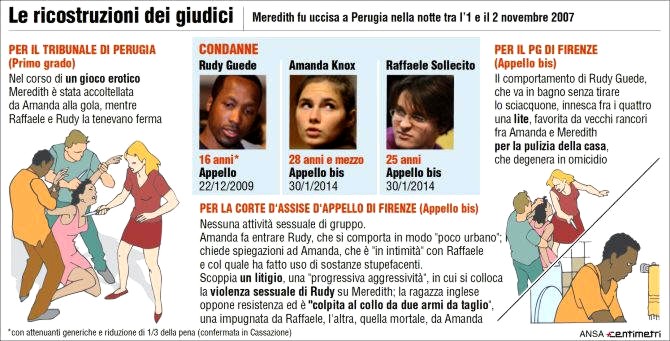
Tuesday, April 29, 2014
The Nencini Report Complains About Multiple Instances Of Evidence Tampering And Criminal Slander
Posted by Our Main Posters

[Edda Mellas, Curt Knox and Chris Mellas might be among those knee-deep in the soup]
Already investigations were under way into a PR campaign that in Italian juidicial terms seems little difference from a criminal enterprise.
Now Judge Nencini has included strong complaints in his sentencing report about nefarious behavior. This might now set a number of people to wondering if they have painted felony targets on their own backs, though the seriously dopey ones may have to have it spelled out for them.
This summary of the complaints is from Andrea Vogt’s excellent report in The Week/First Post which also highlights the appeal findings.
1. Interference with the courts
...during the course of Knox’s long and drawn out judicial process, Judge Alessandro Nencini claims, serious attempts were made to tamper with evidence in a way that would favour her….
In the scathing report that spells out the evidence, logic and reasoning that led to his guilty verdict in Florence on 30 January, Judge Nencini also says Knox and her defence tried to tamper with evidence and pervert the truth by introducing prisoners as witnesses, whose testimony turned out to be false and induced by “other interests”.
“It is clear how this trial was subject to heavy evidence tampering, both internally (slander) and externally,” Nencini writes.
He calls the media interest in the case “fertile ground” that led a number of witnesses to give misleading testimony in exchange for their moment in the limelight.
He also slams the first appeal court’s independent experts for having been oddly superficial and illogical in their analysis of the DNA evidence, especially regarding the potential for contamination, noting that controls were in place to prevent it….
2. Vilification campaign post 2011
Knox and Sollecito were released from prison in 2011 after an appeals court sensationally acquitted them of nearly all charges (one charge against Knox stuck: the slander of Congolese pub owner Patrick Lumumba, who she initially blamed for the crime).
The acquittal ruling, however, was later annulled by Italy’s Supreme Court and a second appeal trial in a jurisdiction outside Perugia was ordered. By that time Knox was safe and sound back in Seattle and chose not to return to Italy for her Florence appeal, instead emailing a statement to the judge, proclaiming her innocence. Sollecito attended.
On 30 January, Judge Nencini and a lay panel of jurors issued a guilty verdict and handed down an even harsher sentence: 25 years for him and 28.5 years for her.
Knox went on national television back in the US the following day claiming, as she always has, that she continues to be the victim of a gross miscarriage of justice carried forward by inertia by dozens of Italian judges.
But in his report, Nencini suggests the gross miscarriage was by Knox and her defence lawyers: indeed, he gave her a longer jail sentence precisely because of the gravity of the slander against Patrick Lumumba aimed at getting investigators off her back.
A small group of fervent supporters continue to lobby on Knox’s behalf and earlier this month she attended an Innocence Project conference with other exonerees, even though Italy’s courts have upheld her convictions….
With this latest development… there appears little wriggle- room for either Knox or Sollecito. Italy’s Supreme Court is expected to give the final ruling on the case after September.
This post was about Amanda Knox’s seriously surreal appearance at that conference of the Innocence Project.
We will soon post a helpful roadmap to all the other numerous suggestions of nefarious behavior on which we have posted. We dont mean to isolate out just Edda Mellas, Curt Knox and Chris Mellas.
Amanda Knox with her highly defamatory website and new charges pending for her book is one of the worst offenders.
Why Final RS & AK Appeal Against Guilty Verdict May Fail: Multiple Wounds = Multiple Attackers
Posted by Our Main Posters
Reports From Italy On Why AK & RS Appeal Failed
The Nencini Report has been released and we are seeing to its translation right now.
Meanwhile journalists in Italy have these reports which convey the very implacable, damning tone. There was nothing accidental about Meredith’s death; Knox premeditated it all along.
First report
From Il Messagero kindly translated by Miriam:.
FLORENCE - The knife that was seized at Raffaele Sollecito house is the knife that killed Meredith Kercher, and the blow was delivered by Amanda Knox. So writes the President of the Court of Appeal of Florence, Alessandro Nencini, in the motivation report of the sentence that was passed on Jan. 30th that saw Amanda Knox sentenced to 28 and a half years and Raffaele Sollecito to 25 years.
Over 330 pages in which the court covers the appeal and explains the conviction. Starting with the knife considered “not incompatible with the wound that was carried out on Meredith Kercher. “In the present case, writes Nencini what counts is the accessibility of the weapon by the accused, it’s concrete portability from house to house, it’s compatibility with the wound, and the presence of Meredith’s DNA on the blade. All of these elements ascertained by the court lead to the conclusion that the knifed evidenced as no. 36 was one of the knifes used in the attack, and was the knife that Knox used to strike the fatal blow to Meredith’s throat.”
The court retains to have sufficient evidence of “certain reliability” of Rudy Guede (convicted to 16 years) Amanda and Raffaele in the house where Mez was killed, on the night between the 1st and November 2, 2007 in 7 Via della Pergola “in the immediate phases following the murder.” The Court then tells how she was immobilized and Mez “was not able to put up some valid resistance because she was dominated by multiple assailants and cut at the same time with the blades of several knives.”
Rejected therefore is the defense’s strategy of both of the convicted, that have always maintained that the killer was only one.: the Ivorian Rudy Guede.
Second report
Bullet points from various Italian media.
- The big knife from Sollecito’s house held by Amanda Knox caused the fatal wound to Meredith while the other was held by Raffaele Sollecito.
- There is strong “multiple and consistent” evidence of all three in the house immediately following the murder. All three worked to suppress Meredith.
- There was an escalating quarrel between Knox and Meredith leading to a progressive aggression and murder with sexual components.
- Between Amanda and Meredith there was no mutual sympathy and Meredith harbored serious reservations about the behavior of AK.
- The biological trace found on the bra clasp that Meredith Kercher was wearing the night she was murdered was left by Raffaele Sollecito
Third report
No especially accurate reports in English have appeared yet and the erroneous “new trial” is still surfacing. Andrea Vogt tweets that she will be posting an analysis soon.
The mischievous defense-inspired “sex game gone wrong” and “satanic theory” mantras are still widely showing up in the duped media, but are nailed hopefully finally in this new report.
Judge Nencini has closely followed and endorsed the “from all angles” Massei trial analysis, but with the inclusion of some more credible explanations from Prosecutor Crini which Judge Micheli had also espoused back in 2008.
In particular, Rudy Guede is not now highly improbably seen as the one initiating the attack on Meredith, and sex was not at all the primary driving force for the attack (the prosecution never ever said it was). Knox carried the big knife from Sollecito’s for a purpose.
The bad blood between the girls resulting from Knox’s crude, brash, very lazy, drug-oriented behavior was well known in Meredith’s circle. All of them had backed away from her, as also had her employer and the patrons in his bar.
There was a probable theft of money by Knox who was unable to account for a sum similar to what Meredith would have stashed away for the rent and that is seen as the probable spark for the explosive argument and attack.
Fourth report
Barbie Nadeau in The Daily Beast
Amanda Knox apparently did not kill Meredith Kercher in a “sex game gone wrong,” as had been previously decided by a lower court in Perugia, according to a Florentine appellate judge who released today a 337-page document explaining his decision to convict Knox and her erstwhile Italian boyfriend, Raffaele Sollecito, for Kercher’s murder. Rather, the judge claims, Knox allegedly killed Kercher, her 21-year-old British roommate, because she didn’t like her.
All Italian courts require judges to explain the reasoning behind their rulings, and it likely represents the penultimate step in a seven-year case that has seen Knox and Sollecito first convicted in 2009 then acquitted in 2011 then convicted again in January 2014. Rudy Guede, an Ivory Coast native who was also convicted for his role in the murder back in 2008, is serving a 16-year jail sentence. He is currently eligible to apply for work furloughs from prison.
Judge Alessandro Nencini, along with a second judge and six lay jurors, were tasked with hearing a second appeal that began in September 2013 after Italy’s high court threw out the acquittal that set Knox and Sollecito free in 2011. Italy’s high court cited “inconsistencies” and “legal mistakes” and tasked Nencini’s court with hearing the appeal again. It was not a retrial per se, but rather a fresh look at the appeal process that freed Knox.
Nencini decided that the appellate court that set Knox free erred in evidentiary and legal matters. That court will now have to rule definitively on the case, using Nencini’s reasoning and whatever appeal Knox and Sollecito file for their final judgment. If the high court accepts Nencini’s verdicts, the two will be required to serve their prison sentences in Italy. Knox has vowed she will not return to Europe, but Sollecito, unless he escapes, won’t be as lucky.
The court’s explanation of its decision comes down hard on the first appellate court that overturned Knox’s guilty verdict, at times seemingly scolding them for misapplication of penal codes and for throwing out witness testimony without explanation. “It was an operation of evaluating evidence with using logic,” Nencini wrote, accusing the first appellate court of essentially throwing out testimony that allegedly proved Knox’s involvement, but keeping testimony that supposedly supported her innocence.
He used Knox’s prison diary as a prime example. “Look at the contradictions in the evaluation of the diary written in English by Amanda Knox,” he wrote, referring to a handwritten prison diary taken fromKnox’s cell as part of the investigation to determine why she accused her pub boss Patrick Lumumba of Kercher’s murder during early interrogations. “On one hand, the appellate court of Perugia completely devalued the writings when she admitted wrongdoing by accusing Patrick Lumumba. On the other side, they valued it when she defended herself.”
Nencini also ruled that there was plenty of forensic evidence tying Knox and Sollecito to the crime scene, writing “they left their tracks in the victim’s blood” more than once in the document. He accepted testimony that supported the theory that a knife found in Sollecito’s apartment was one of the primary murder weapons, and he reasoned that a second knife was also used that matched a blood stain left on Kercher’s mattress.
The first knife in question was the only hard evidence reexamined in the second appeal, and forensic experts ruled that a previously untested spot on the knife’s handle consisted of 100 percent Knox’s DNA. An earlier court heard testimony that a tiny smidgeon of DNA on the groove of the blade was Kercher’s, but the first appellate court agreed with witnesses who testified that the sample was too small to be considered a perfect match. The second appellate court not only considered the knife to be the murder weapon, it also ruled that Knox “plunged the knife into the left side of Kercher’s neck, causing the fatal wound.”
The second appellate court also reasoned that Kercher’s bra clasp, which had been cut from her body after she was killed, had Sollecito’s DNA on the tiny metal clasp. “The biological trace found on the bra clasp that Meredith Kercher was wearing when she was assassinated belonged to RaffaeleSollecito,” Nencini wrote, agreeing with the judge in the original murder conviction. “The clasp was manipulated by the accused on the night of the murder.”
The court also scoffed at certain rulings laid out by the first appellate court, saying that the court’s reasoning that it would have been easy for “a young athlete” like Rudy Guede to scale the wall and enter the apartment, was borderline racist.
Nencini also ruled that with regard to motive in the murder, it was subjective and personal. “It is not necessary for all the assailants to share the same motive.”
The court picked out small details of Knox’s presumably errant testimony, including how she told police the morning Kercher’s body was found that Kercher always locked her door “even when she takes a shower,” which was later contested by the girls’ other roommates.
Nencini also clearly believed ample forensic testimony, presented by experts examining the original autopsy, that Kercher was killed by more than one person. “”She was completely immobilized when she was murdered,” he said, reasoning that Guede could not have acted alone, and instead likely held her back as Sollecito and Knox knifed her.
The judge also pointed out incongruences in Knox’s testimony about the night of the murder, but noted problems with the other witnesses, which included a homeless man, an elderly woman who said she heard screams. Still, he ruled that Knox’s accusation of Lumumba is vital evidence against her. “It is impossible to separate the two acts,” he wrote.
Using Nencini’s reasoning, Knox’s lawyers now have the roadmap for planning their final appeal to Italy’s high court, likely later this year or in early 2015. However, this same high court threw out the acquittal in the first place, so Knox may need more than luck to walk free. If she is definitively convicted, she will likely face an extradition order to come back to Italy to serve out her sentence. There are very few legal loopholes that would allow an American citizen to escape a court decision by a country, like Italy, that shares extradition treaties with the U.S.
[Judge Massei at crime scene; report says why Knox & Sollecito appeal against his 2009 verdict has failed]
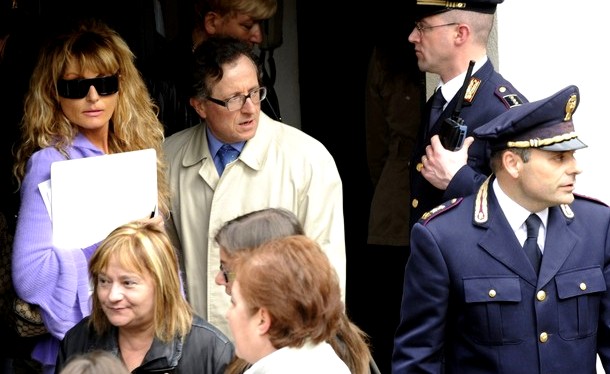
[The Supreme Court in Rome is expected later this year to confirm this outcome]

Sunday, April 27, 2014
Knox & Sollecito Actions In The Week Prior To Arrest: An Incriminating Behavior Pattern For Sure
Posted by James Raper
[Video above: Sollecito slams Knox’s weird behavior, while not explaining numerous examples of his own ]
1. Today’s Context To This Post
A very strong case for guilt has been made at trial and endorsed at the first-level appeal.
This series hammers home the growing hundreds of incriminating stark differences between the official evidence record, Sollecito’s and Knox’s two books, and Sollecito’s and Knox’s multiple conflicting claims since.
The focus of this post as with the one immediately below is upon the described behaviours of Knox and Sollecito, from the very beginning to this very day. This pattern has more than contributed to the certainty of their involvement in the murder of Meredith Kercher.
2. How The Behavior Speaks To Guilt
The early pointer of the staged break-in aside this behaviour gave investigators an insight into the pair’s possible involvement back on Day One: Behavioral pointers have continued on a par with corroborated developments in the case.
It has even continued, incredibly, since their release from prison. For me it is the thread that runs through this case having as much to do with the overall picture of culpability as the other elements .
This behaviour - to include what they have to say for themselves - is a catalogue of the inappropriate, of the implausible, of inconsistencies and contradictions, of evasions and obfuscations, to be gleaned from the accounts of Knox and Sollecito themselves and highlighted in the accounts of other witnesses. It is also to be gleaned from phone and computer records.
Taken together it is a formidable body of evidence which goes to character and culpability. It cannot be attributed to a railroading job, the machinations of a corrupt and evil prosecutor or character assassination by the media. It is also implausible if not impossible to explain it as being due to naivety, confusion or some quirkiness of character.
It amounts to the pair of them concocting stories, telling lies and misleading investigators and the general public.
3. Physical Evidence Array Is Already Substantial
There are numerous items of evidence which are building blocks in the prosecution case and with which we are all familiar.
- 1. The staged break-in via Filomena’s window with pointers to this outside, on the windows and shutters, and throughout the bedroom.
2. The evident partial clean up proved by footprint trails with footprints missing and what was behind the locked door.
3. Amanda Knox’s lamp on the floor behind Meredith’s locked door which she only conceded was her own at trial, under pressure.
4. Knox’s dried and congealed blood on the tap in the small bathroom that Amanda Knox and Meredith shared.
5. The bloody footprint on the mat in that bathroom definitively attributed to Sollecito rather than Guede
6. The mixed DNA of Knox and Meredith Kercher found in blood in the basin, the bidet and on the box of Q tips in that bathroom
7. Two luminol enhanced mixed traces containing DNA belonging to Knox and Meredith Kercher, one in the corridor and the other in Filomena’s room
8. Two luminol enhanced footprints of Knox in the corridor and one of Sollecito immediately outside Meredith’s room.
9. The knife taken from Sollecito’s apartment with Meredith Kercher’s DNA on the blade and Knox’s DNA on the handle and on the blade
10. Meredith Kercher’s bra clasp with Sollecito’s DNA on a hook and contamination possibilities definitively ruled out.
4. Behaviors In The First Week Of November 2007
I don’t want to make this an unduly long post. Accordingly I am going to concentrate on the period up to that famous police interrogation analysed just below. As to that critical period I will be selective but it should be enough.
The Lady With The Mop?
The story (in Knox’s e-mail) that she had visited the cottage to collect a mop, have a shower and get a change of clothing, earlier on the morning of the 2nd November, but did not notice that Filomena’s window had been broken and her room trashed is just that - a made up story. It is entirely implausible and the account unreliable for a number of reasons including-
- (a) it is hard to believe that she did not notice the hard to miss fact that the shutters to Filomena’s window were (as they were found) open - this would have alerted her to the likelihood that Filomena was back home which she would, of course, have checked out of curiosity if nothing else given that she found no one home.
(b) her claim that Filomena’s door was shut is contradicted by Sollecito who wrote (prison diary) that when he later entered the cottage with Knox Filomena’s door was wide open.
(c) it is hard to believe that she took a shower without noticing until after her shower (as she claimed) that there was blood on the bathroom mat, including a bloody footprint. In fact she didn’t even claim to notice that it was a footprint despite the fact that it was obviously so.
(d) it is hard to believe that having found the front door wide open and having found blood, and having opted for a shower and to blow dry her hair, she never got round to checking for any sign of Meredith’s presence. Any one else would have tried her door to check whether or not she was home.
(e) from her appearance at the cottage that morning it is hard to believe that she took a shower at all (let alone blow dried her hair) and the cops remarked that she reeked of body odour.
(f) less problematic but nevertheless still somewhat surprising is that as she is drying her hair she makes a fuss over shit (left by Guede) in the toilet, describes herself as being “uncomfortable” about it but does not flush it away before grabbing the mop and leaving.
The Two Stayed At Home?
The story that Knox and Sollecito had spent the previous night (the night of Meredith’s murder) indoors, critically from 9 pm onwards, that both had slept and that Knox had been the first to rise at about 10.30 am the next morning is implausible and uncorroborated, not only because this alibi is directly contradicted by the testimony of Curatolo and Quintavalle, and Sollecito’s statement to the police that Knox had gone out and not returned until about 1 am, but also in view of the following facts.
- (a) Curatolo claimed to have first seen the Knox and Sollecito in Piazza Grimana shortly after 9.30 pm but Knox claimed in her trial testimony that she and Raffaele had cooked and eaten a meal between 9.30 and 10 pm.
GCM: Can you say what time this was?
AK: umm, around, umm, we ate around 9.30 or 10, and then after we had eaten, and he was washing the dishes, well, as I said, I don’t look at the clock much, but it was around 10. And”¦he”¦umm”¦well, he was washing the dishes and, umm, the water was coming out and he was very bummed, displeased, he told me he had just had that thing repaired. He was annoyed that it had broken again. So”¦umm
LG: Yes, so you talked a bit. Then what did you do?
AK: Then we smoked a joint together”¦”¦we made love”¦..then we fell asleep.
Unfortunately Sollecito’s father himself torpedoed this dodge by telling the court that when he phoned his son at 8.42 pm Sollecito had told him that there had been a water leak while he was washing the dishes. Taking into account Knox’s testimony that they had eaten before the dish washing, this places the meal and dish washing before that call.
(b) Sollecito told the police that at about 11 pm he had received a call from his father on his land line. Not only is that not confirmed by his father but there is no log of such a call.
(c) There is no log of a call to his mobile at that time either though his father had sent a text message at that time but which Sollecito did not receive until 6. 03 am the following morning. We know that he had received it at that time because that is the time at which it is logged in the phone records. Sollecito had just turned his phone on and clearly the phone had been off when the text message was sent.
(d) There is no record of any phone activity for either of them from after the 8.42 pm call to, in Sollecito’s case, receipt of that text message at 6.03 am, and in Knox’s case her call to Meredith’s English phone at 12.07 pm the next day.
A further word about this Point (d) here as Knox has released her phone records on her web site. In her case it has to be said that this is not so unusual. Up until the 30th October there is no regular pattern of late or early morning phone activity.
It is interesting to note, however, that as of the 30th October there is a spate of texts and calls between her and a young Greek known to us as Spiros. Communication between them had in fact been going on since the beginning of October but there are 5 texts in the afternoon of the 30th, two telephone calls in the afternoon and a call at 11.38 pm on Halloween.
In the early hours of the following morning there are a couple of calls between the two. In fact we know that the two met up together for Halloween as Knox was at a loose end. Meredith had shrugged her off and Raffaele was attending a friend’s graduation dinner out of town.
Sollecito is different as his father was in the habit of calling at all hours just to find out what his son was doing and, as we know, he had called late only to find that his son’s phone was switched off.
In the case of Knox she admitted in any event that her phone had been switched off, “to save the battery”.
(e) There is no record of any activity on Sollecito’s computer after 9.15 pm and until 5.32 am the following morning when music was played for half an hour. This contradicts the claim that Sollecito had smoked pot and interacted with his computer until midnight and that they had both slept until late the following morning.
(f) The fact that the next morning, outside the cottage, both Knox and Sollecito looked utterly exhausted. This belies the alibi that they had spent a quiet night indoors and had only risen late that morning.
The Fake Call To Knox’s Mum in Seattle?
Knox falsely claims in her book that having had her shower she called her mother on her way back to Sollecito’s apartment as she was beginning to have concerns as to what she had seen at the cottage. Her mother tells her to raise her concerns with Raffaele and the other flatmates and Knox says that she then immediately called Filomena. Filomena tells her to get hold of Meredith by phone which she tries to do by calling Meredith’s English phone first, then her Italian one.
- (a) How does this correlate to the contents of her e-mail of the 11/04/07?
(b) How does this correlate to Knox’s phone records?
(c) There is no mention of a call to her mother at all in the e-mail. This from her e-mail -
“”¦.and I returned to Raffaele’s place. After we had used the mop to clean up the kitchen I told Raffaele about what I had seen in the house over breakfast. The strange blood in the bathroom, the door wide open, the shit in the toilet. He suggested I call one of my roommates, so I called Filomena”¦”¦”¦..
Filomena seemed really worried so I told her I’d call Meredith and then call her back. I called both of Meredith’s phones the English one first and last and the Italian one in between. The first time I called the English phone it rang and then sounded as if there was disturbance, but no one answered. I then called the Italian phone and it just kept ringing, no answer. I called the English phone again and this time an English voice told me the phone was out of service.”
(d) the phone records are as follows for 2 November 2007:
Ist call of the day @ 12.07.12 (to Meredith’s English phone) - 16 seconds
2nd call @ 12.08.44 (to Filomena) - 68 seconds
3rd call @ 12.11.02 (to Meredith’s Italian phone) - 3 seconds
4th call @ 12.11.54 (to Meredith’s English phone) - 4 seconds
8th call @ 12..47.23 (first call to her mother) - 88 seconds
(e) The discrepancies are numerous, see these examples:
1. The first call to her mother was not just after leaving the cottage but 40 minutes after the call to Filomena, and the call to Filomena had been placed after she had returned to Raffaele’s place and after they had used the mop and had breakfast. In fact, say about an hour after she left the cottage.
2. The first call to Meredith’s English phone was placed before the call to Filomena, and not after as Knox would have it in her e-mail. A minute before, but Knox did not mention this to Filomena, as confirmed by the e-mail and Filomena’s testimony.
3. The first call to Meredith’s English phone disappears entirely in Knox’s book.
4. The call to the Italian phone did not just keep ringing. The connection was for 3 seconds and this was followed by a connection to the English phone for 4 seconds.
5. The English phone was not switched off or out of service. Mrs Lana’s daughter had found it. She said that she would not have done so but for it ringing (the 12.07 call for 16 seconds?). She picked it up and took it into the house where it rang again (the 12.11 call - 4 seconds?). A name appeared on the screen as it rang : “Amanda”.
6. The 3 and 4 second calls are highly suspicious. The Italian phone was undoubtedly in the possession of the postal police. According to Massei it’s answering service was activated, accounting for the log. Clearly Knox did not even bother to leave a message for Meredith as it would take longer than 3 seconds just to listen to the answering service. This is not the behaviour of someone genuinely concerned about another.
- Observations:
1. In her e-mail, and repeated in her trial testimony, Knox says that she woke up around 10.30 am, grabbed a few things and walked the 5 minutes back to the cottage. If the first call to her mother was about an hour after she left the cottage (see before), then she left the cottage at about 11.47 am, which means that she spent over an hour there. Either that or she spent more (a lot more) than 20 minutes at Raffaele’s place before calling Filomena. The latter would be more likely as it is difficult to conceive that she spent over an hour at the cottage. She didn’t have the heating on when she was there. Either way there is a period of about an hour and a half between when she might have tried to contact Meredith or raise the alarm and actually doing so.
2. That we are right to be incredulous about this is borne out by the false claim in Knox”˜s book. That false claim is significant and can only be because Knox is aware of the problem and feels she needs to add some support to her implausible story of the mop/shower visit and to conceal the real reasons for the inactivity and delay connected with it.
3. That it is incredible is even belatedly acknowledged by Sollecito’s feeble but revealing attempt to distance himself from Knox in a CNN interview on the 28 Feb this year. “Certainly I asked her questions” he said. “Why did you take a shower? Why did you spend so much time there?”
4. That she makes that false claim and has constantly stonewalled and/or misplaced the 16 second call to Meredith’s English phone is indicative of her guilty knowledge. Her guilty knowledge with respect to the 16 second call was that it was made to ascertain whether or not the phones had been located before she called Filomena, and hence for her it was not (incredulous though this is without such explanation) a pertinent fact for her to bring up with Filomena.
The Real Call To Knox’s Mum In Seattle?
As to the 12.47 call to her mother itself (4.47 am Seattle time and prior to the discovery of Meredith”˜s body) Knox not only did not mention that in her e-mail but in her trial testimony she steadfastly declined to recall that it had occurred.
She clearly did not want, or could not be trusted, to discuss why the call had occurred and what had transpired in conversation with her mother before the discovery of Meredith’s body.
Not only was the timing of the 12.47 call inconvenient to her mother but I found it interesting to note from Knox’s phone records (covering 2nd Oct - 3rd November) that mother and daughter do not appear to have called or texted each other once up until that 12.47 call.
It would appear then that in so far as they remained in direct communication with each other for that period it must have been by e-mail. One can therefore imagine that her mother was very surprised to receive that call.
It is also very difficult to accept that Knox could not recall a phone call she was not in the habit of making. (On the other hand the same records show that it was not at all unusual for Knox and Meredith to communicate with other on Meredith’s English phone.)
Sollecito’s Call From His Dad?
At the cottage, and prior to the above call, Sollecito received a call from his father at 12.40 am. Do we know what they discussed? It would in any event have been after the discovery of Filomena’s broken window and (allegedly) Sollecito’s (rather feeble) attempt to beak down Meredith’s door.
Did the responsible adult advise his son to do the obvious and call the police? One would think so, but then why was there a 10 minute delay before he called his sister in the Carabinieri at 12.50 am? Indeed, why call his sister at all? Filomena had also urged Knox to call the police when she called at 12.35.The delay might be explained by the unexpected arrival of the postal police and if this was the case then it was before Sollecito called the 112 emergency services.
The Claims Of Finding Meredith’s Body?
Neither Knox nor Sollecito saw into Meredith’s room when the door was broken down and her body discovered on the floor under a quilt. Yet in the immediate aftermath it is as if they have wanted others to believe that it was they who discovered her body and in the bragging about this there have been disclosures, not only as to what they should not have been aware but also suggestive of disturbed personalities. This behaviour was remarkable for all the wrong reasons.
- (a) Luca Altieri”˜s testimony makes it clear that Knox and Sollecito had heard about Meredith”˜s cut throat directly from him during the car ride to the police station.
However her bizarre and grotesque allusion in the early moments of the investigation to the body being found stuffed into the closet (wardrobe) is not just factually incorrect (it was lying to the side of the closet) but bears correlation to the later forensic findings based on blood splatter in front of and on the closet door, that Meredith had been thrust up against the closet after having been stabbed in the throat.
(b) The behaviour of Knox and Sollecito at the police station is documented in the testimony of Meredith’s English girlfriends and of the police. Whilst it is true that people react to grief in different ways it is difficult to ascribe grief to Knox’s behaviour. Emotionally she was cold towards Meredith’s friends and occasionally went out of her way to upset them with barbed and callous remarks.
The fact that Knox was not observed to cry and wanted to talk about what had happened is not of itself indicative of anything but remarks like “What the fuck do you think, she bled to death” and her kissing and canoodling with Raffaele (including them making smacking noises with their lips when they blew kisses to each other) in front of the others was not normal.
Rather chilling in retrospect was a scene between the pair of them when Knox found the word “minaccia” ( in english - threat) amusing and made a play of it with Sollecito in front of witnesses.
(c) Grief is in any event reserved for friends and relations, or people one much admires. The evidence is that the initial short friendship between the two had cooled to the extent that Meredith was studiously, if politely, avoiding being around Knox. For the narcissistic and attention seeking american girl this would have been difficult to ignore and may well have offended her.
(d) The next day Sollecito was willingly collared by a reporter from the Sunday Mirror and told her about the horror of finding the body.
“Yes I knew her. I found her body.”
“It is something I never hope to see again,” he said. “There was blood everywhere and I couldn’t take it all in.”
“My girlfriend was her flatmate and she was crying and screaming, ‘How could anyone do this?’”
Sollecito went on to tell the reporter that “It was a normal night. Meredith had gone out with one of her English friends and Amanda and I went to party with one of my friends. The next day, around lunchtime, Amanda went back to their apartment to have a shower.”
About the only thing that is true here is that he knew Meredith.
Wednesday, April 16, 2014
The Incriminating Bathroom Evidence: Visual Analysis shows the Footprint IS Sollecito’s
Posted by Machiavelli
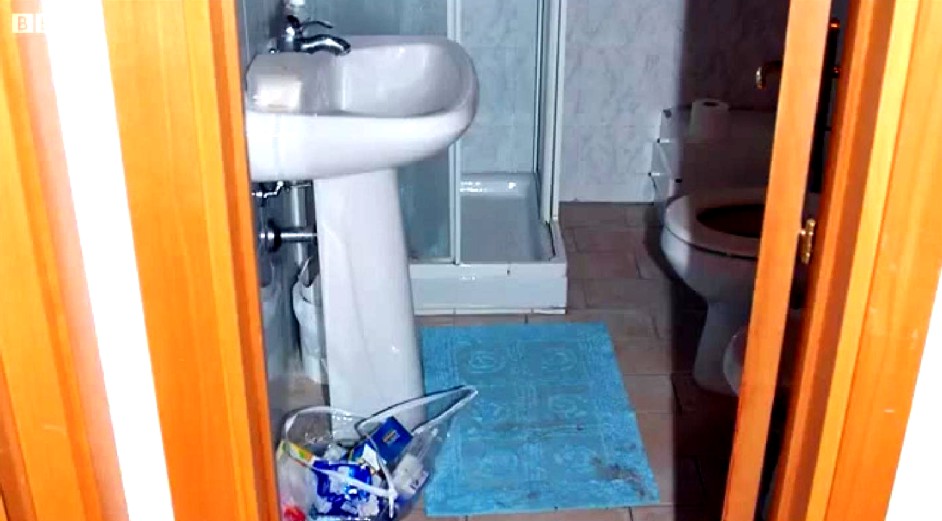
[Please click on each image for a larger and more high-resolution version]
The sheer depth and width of the hard evidence
The defenses really don’t want you to know this: in both width and depth, the full panoply of the evidence against Knox and Sollecito is absolutely overwhelming.
As we remarked in our post below there are far more and far stronger evidence points than UK and US courts normally require for conviction. But only the trial panel of judges observed anything like their full array.
The 2010 Massei Trial Report (which the Nencini Appeal court validated this past January) is a SUMMARY of what was presented to the judges in the courtroom. Those presentations in court were in turn something of a SUMMARY of the hard evidence buried in all the evidence files and the minds of witnesses.
Italian media SUMMARISED for Italians what was to be seen in the courtroom and to be read in the Massei Report. They were barely able to do even summaries for the 1/4 of all the trial hearings that were not open to the media or the public.
UK and US media for the most part didn’t even bother to provide comprehensive summaries (the very fine on-the-spot reportings of Andrea Vogt, Barbie Nadeau and Ann Wise were the main exceptions).
So in effect people in the UK and US attempting to follow the story didnt for the most part receive even a summary of a summary of a summary!
Not one US or UK newspaper or TV network translated the Micheli Report, or the vital Massei Report, or the Supreme Court appeal, or the Supreme Court outcome - only the (mostly professional) translators on PMF dot Org did all that translation.
This post is another example of how far down - beyond even Massei - it’s possible to drill into the evidence, and see it still hold up.
Some past posts on TJMK drilled down to similar depths, on the knives, on the DNA, on the mixed-blood traces, on the phone-events, on the motives and psychologies, and so on. All that evidence too all held up.
Visual analysis of the bathroom-mat footprint
This post mainly consists of high-resolution pictures and measurements. Presented like this, the pictures and measurements largely speak for themselves, and show the real strength of the bathroom-mat footprint evidence.
You will see that as SomeAlibi previously concluded using other methods, this footprint was quite undeniably Sollecito’s. It bears no similarity at all to Rudy Guede’s.
Please click on all images for larger versions in scalable PDF format
1 . [Below] the bathmat and the print, with measurement reference
2 . The bathmat print and the surrounding area
3 . The bathmat print (photo from Polizia Scientifica).
4 . The bathmat print, with vertical and horizontal sizes, from Rinaldi’s report
5. The bathmat print, photo with enhanced contrast.
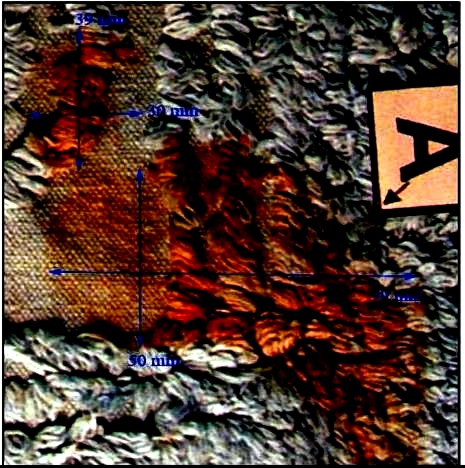
The photo above was modified by highly enhancing contrast.
6 . Enhanced contrast helps to spot some features
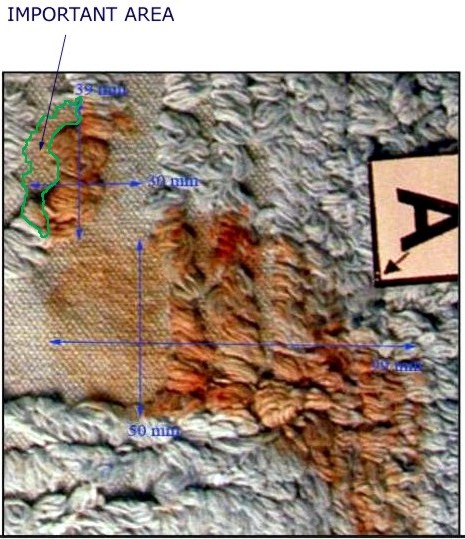
Contrast may help to highlight especially some parts of the print outline.
For example the area on the left labeled as “important area” in the picture (which was “forgotten” in the notorious photo elaborations disseminated by the ‘Friends of Amanda’ group), shows the actual left outline of the “˜big toe’ of the bathmat print.
The toe includes the area indicated in this picture (here the picture is shown again in its original colours).
7. The bathmat, with enhanced contrast
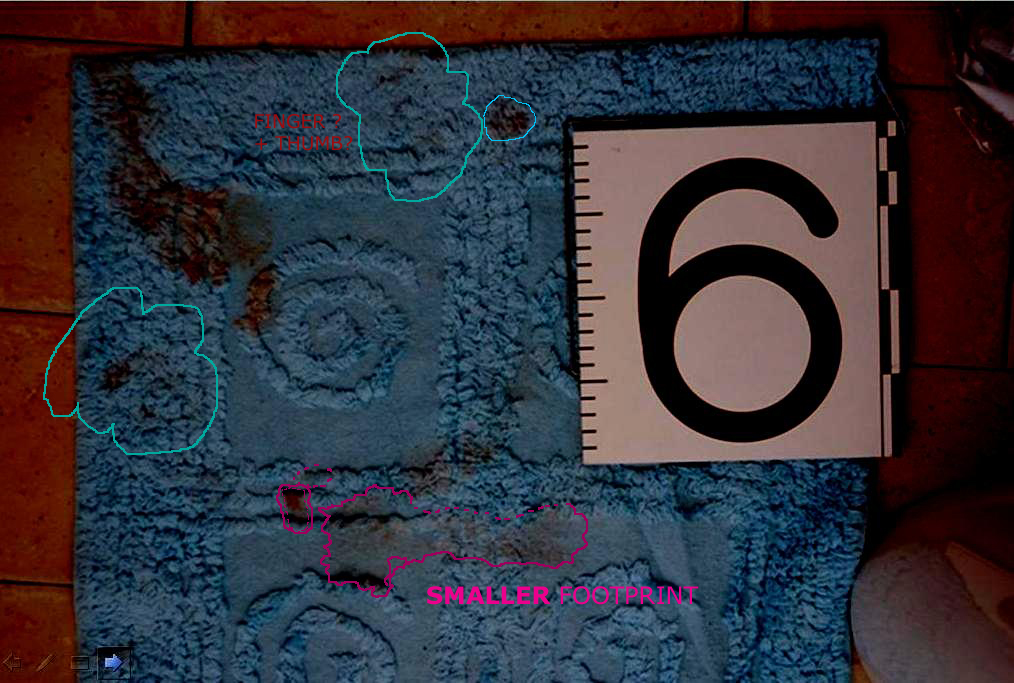
The contrasted image is showing the presence of other stains
There are other stains on the carpet (about another 10, factually situated in one half of the mat area), and also there shows a second diluted footprint (apparently from a foot of smaller size).
8. The selection of a set of red colour shades, outlined by an automatic outline generator
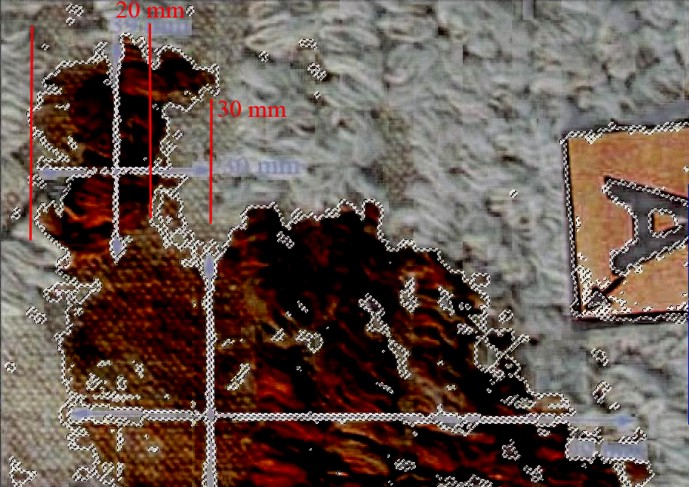
Shows the shape and the possible “˜outline’ of the stain
Reference measurements indicate the width of the “˜big toe’ in millimetres.
9 . A hand drawing of the outline (detail).
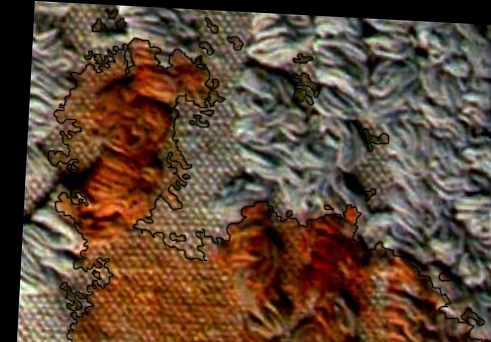
The photography above was modified
The modifications are: +28% contrast, -8% luminosity, + 20% colour saturation, from the original.
An outline has been drawn manually on the photoshop image, trying to be as faithful as possible to the actual stain.
You can notice that, apart from some minor “˜disputable’ very faint areas (such as the area between the toe and the metatarsus) there are only minimal differences between an automatically generated outline and a manually drawn one.
The shapes of the “˜big toe’ are extremely similar in both contours (images 8 and 9), in fact all meaningful features are basically identical.
We consider this manually drawn outline as good for comparison.
10 . The complete hand-drawn outline
11 . Minor detail: small dots separated from the main stain

Observe the small red ‘dots’ in the picture above
Although we can’t draw any conclusion about their possible significance, we note the existence of these very small “˜spots’ of a faint red colour shade, separated from the big stain.
They are detected by the computer generated outline above, and that we also see as distinguishable with the naked eye thus we considered them in drawing manually the outline.
We don’t draw any conclusion about them; but because of their sensitive position (they may suggest a “˜small toe’ mark) we take note of them.
The green arrows in the picture point out their position (green circles).
12 . An image in electronically modified colours
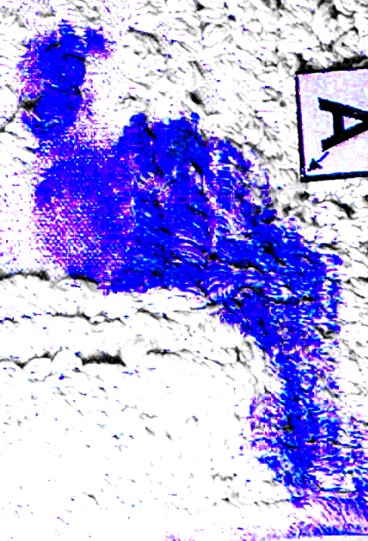
Distribution and intensity of the colouration
As a part of the preliminary study of the stain, we also produced this image above where the computer assigned an artificial colour to an array of shades of ‘red’, thus allowing to further isolate the stain from the background for further assessments about its shape.
This picture shows the distribution and intensity of the colouration. (note: the existence of some above mentioned tiny marks is recorded by this technique too)
13 . The bathmat has a spiral-shaped relief decoration
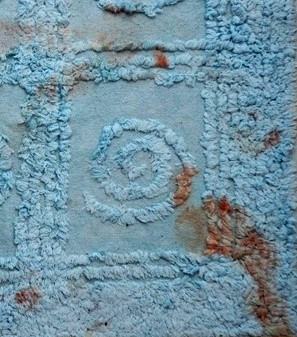
The footprint’s toe obviously balancing on top of the relief decoration.
We think the outline of the “˜toe’ mark of the bloody footprint is affected by the shape of the decoration, in particular the missing part of the toe on the right side, which is remarkably coincident with the margin of the decoration.
So that on that side there is a striking correspondence between the outline of the “˜negative area’ ““ the fabric surface around the spiral, which is lower ““ and the big toe’s outline
This indicates that the outline of that mark on that side was affected by the decoration margin, thus the print there has a “˜missing part’. So the “˜crooked’ bloody area in fact follows the margin of a larger toe.
Because of such coincidence, we can logically assume that the actual shape of the big toe mark appears to be part of a big toe, with larger surface which left its print only partly because part of its surface did not have contact with the fabric, in correspondence of the “˜negative area’.
14. The “negative area”
15. Mat decoration in relief and the toe mark
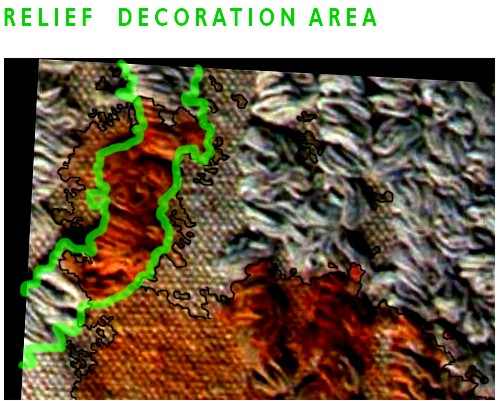
Observe above one single, unitary stain
The remarkable coincidence between the outlines of the decoration in relief and of the toe mark is shown in the picture above.
The rough contour of the print obtained through a smooth curve highlights the shape of the big toe.
Part of the relief decoration outline coincides with the toe mark outline, which shows, highlights and explains how all parts of the red toe mark, that you can see left of the relief decoration, they all belong to one single, unitary stain.
Thus we can deduce that the “missing” area on the right of the toe is determined by the decoration, and coincides with the negative area.
16. Picture (by Kermit) showing a rough shape of the stain
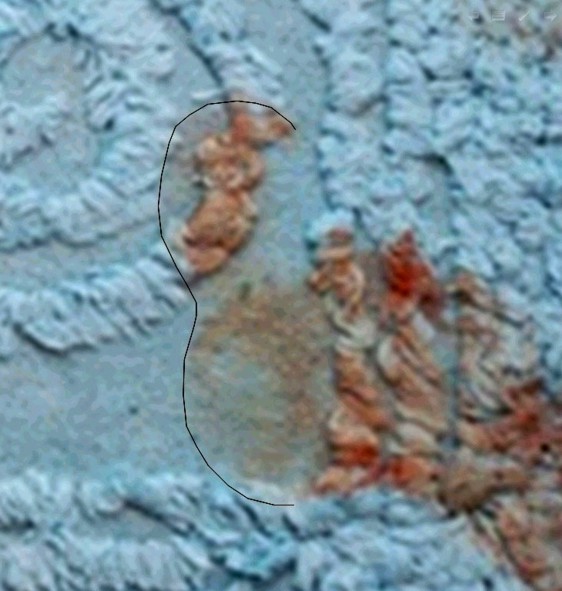
Observe shape, curvature and size
This drawing by Kermit above highlights the rough shape, curvature of left margin and overall size of the big toe.
17. Rudy Guede’s sample print
A copy of this picture together with one of Sollecito’s print at the same scale will be used for comparisons.
18 . Raffaele Sollecito’s sample print
A copy of this picture together with one of Guede’s print at the same scale will be used for comparisons.
19. Part of Rudy Guede’s sample print with Rinaldi’s reference measurements
20. Part of Sollecito’s sample print, with Rinaldi’s reference measurements:
21. Bringing all photographs down to the same scale
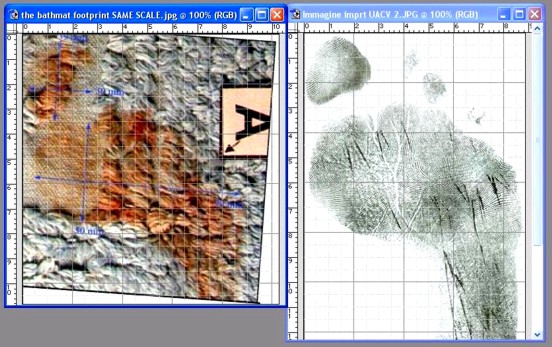
An accurate exercise of scaling was done
This was based on Rinaldi’s referenced pictures. Each one of the Rinaldi’s sample pictures has multiple measurements on several points of reference which allow a high precision determination of their scale and sizes, and thus comparison at the same scale.
In order to further increase scaling precision, the scale was calculated previously and separately for each comparative measurement in the three photos; this was done multiple times for each measurement and the average was picked in order to reduce error as for statistical measurement method.
The resulting final error in the scale is extremely small, far below a threshold of significance that could affect comparison (which was set arbitrarily at 1%, but it’s probably significantly higher, while the actual error is much lower).
In other words, the scale error that may affect your screen pictures will be definitely smaller than any possible perceivable (either significant or tolerated) difference that would be noticed or that may affect the attribution of the stain, when this is compared to the sample.
22. The hand drawn outline is shown again here
23 . The outline (matched scale) overlapped on Sollecito’s sample footprint
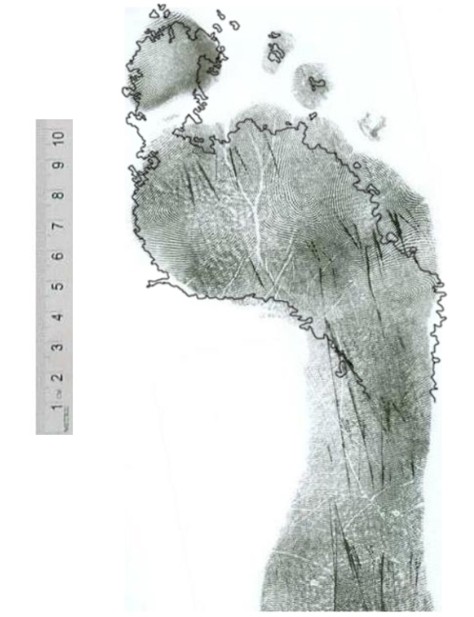
The array of compatibilities with Sollecito
The bathmat stain does not seem to have major incompatibilities with Sollecito’s print; it shows rather an array of compatibilities that can be perceived visually.
One interesting feature is the shape, size and position of a ‘big toe’, that appears as a remarkable coincidence; the toe also has a kind of cleft (see 28 below) on the curvature of its left margin. Another outstanding coincidence is the curvature of the plantar arch on the left.
24 . The same outline overlapped on Guede’s footprint
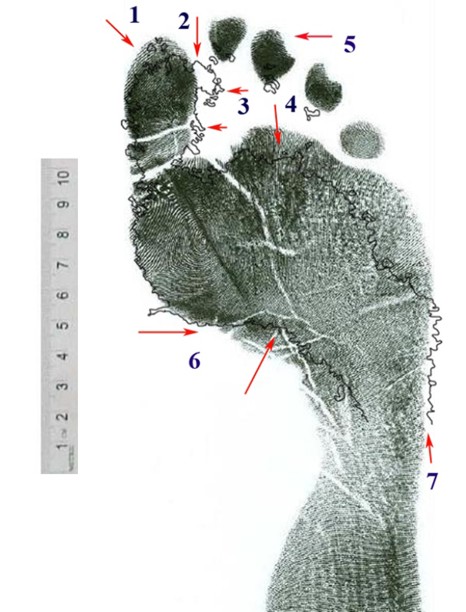
Compare with Guede’s - matched scale.
If you look at the overlapping of the stain outline (see pic 22.) with the sample of Guede’s print (see pics 17. 19.), you may notice 7 major differences, showing a failure of compatibility. Those differences are indicated by numbers (1-7) in the picture .
Each one indicates an area of major difference between the outline of the bathmat stain and the outline of Guede’s sample print. Those measurement differences are remarkably larger than those that can be detected on the overlapping with Sollecito’s sample print.
On the other hand, the compatibility between Sollecito’s print and some very peculiar aspects of the bathmat print (such as a 30mm wide and short toe) were absolutely remarkable.
The differences between the bathmat stain and Guede’s print are :
1) Toe mark of stain is significantly SHORTER than the big toe in Guede’s sample print (a difference of about 7 millimetres). Some people may want to attempt an objection, by suggesting that such a difference may be just a consequence of the position chosen for the overlapping, that maybe the bathmat print was just positioned too low in the picture, the problem may be solved by shifting it up about 7 millimeters so as to make the tip of the bathmat toe ‘coincide’ with the tip of Guede’s print toe.
However, such objection wouldn’t work; it’s a wrong argument. In fact the only possibly correct position for overlapping the bathmat stain outline is determined by the left curvature of the ball of feet and plantar arch (the area of the picture near number 6), which is by the way the most clearly outlined part of the bathmat stain. If you shift the bathmat stain upwards, the outline will miss the match with the curvature of the left margin of the ball of the feet. You will notice that the plantar arch in this area is already very incompatible with Guede’s plantar arch. It tends to become even more incompatible the more you shift the bathmat stain outline towards the toe.
The problem has no solution, since the more you shift the stain outline upwards (in the direction of the toe) in an attempt to make it look more ‘compatible’ with the length of Guede’s toe (or with an upper margin) the more it will become incompatible with the plantar arch. In order to limit the incompatibility of the plantar arch, and in order to keep an overlapping of at least the left margin of the ball of the feet, you need to place it as shown in the picture, this is the position of ‘maximum’ compatibility between the bathmat stain and Guede’s print. Conclusion: the bathmat toe is too short.
2) Toe mark of stain is TOO WIDE (30 mm). It is much wider (30 mm) than Guede’s toe. The number 2. indicates the protruding mark at the upper right, the mark which Giulia Bongiorno desperately insisted on calling a “second toe” mark. In fact, not only would the mark miss completely any hypothetical Guede’s ‘second toe’ in any possible position of the print; also you may notice (highlighted by pics 8. and 9.) how it is not a “mark” itself, but actually it just part of the same area which is entirely continuous in shape and coloration with the rest of the toe mark, and - the most remarkable feature - its right outline is coincident with the outline of the spiral-shaped relief decoration, so that you can reasonably conclude that it is determined by that (the missing area at the lower right of the ‘big toe’ is determined by the existence of the “negative area” of the bathmat decoration).
Conclusion: the bathmat stain has a wider toe mark, however one likes to call it (“big toe”, or “big toe + second toe”) that fails to match any possible part of Guede’s print. The bathmat print is clearly different and incompatible with Guede’s print. It simply cannot be overlapped to any part of Guede’s sample print. Such area is a very significant difference that points outright to incompatibility between the stain and Guede’s print.
3) The toe mark is larger also in the area located at the lower portion of the toe. The toe of the bathmat print in fact has a ‘right margin’ which actually has some additional small marks, small drops protruding towards the right, like droplets maybe produced by the wet cotton fibres of the part in relief which protrude towards the right. This tends to suggest the toe area of the stain may in fact be considered wider: the object that produced it was definitely wider than 22mm, in this area of the toe as well. So also a look at this area confirms that the bathmat stain is wider than 22-23 mm (more towards 30 mm) not just when measured at the upper corner (number 2.) but also at its “lower” parts; here, the small marks caused by the liquid suggest that a larger surface has squeezed liquid from some fabric threads leaving some trace also on the lower area.
4) Bigger incompatibility of Guede on the metatarsus front outline. This area is the front outline of metatarsus: the stain is almost 1cm shorter than Guede’s metatarsus. This happens when you chose the overlapping so as to make the left outline and plantar arch (6.) of metatarsus coincide, as in the picture. Sollecito’s sample print also shows some difference from the stain in this area (pic. 23.) but the difference between the stain and Sollecito’s print is significantly smaller than what you can see in Guede’s print.
5) There are NO SMALL TOES in the bathmat stain. Small toes are completely absent from the bathmat stain (while the tiny blood marks around the stain don’t coincide with their expected position if it was Guede’s print). Such lack of small toes is a peculiarity of the bathmat print. This is a remarkable difference from Guede’s print, and at the same time, a considerable analogy with Sollecito’s print. In fact one outstanding feature of Guede’s print is the evidence that Guede places a big load of weight on his small toes while instead Sollecito has a posture with a weight distribution with the contrary tendency, and obviously he almost does not touch the ground with his small toes.
Thus, Guede’s small toes are all very well pressed on the ground and thus, we can reasonably infer they are somehow naturally likely to get wet if he steps on any wet surface, and anyway they should get wet for sure if the foot is immersed in water or washed (the foot that left the bathmat print must have been immersed in bloody water). The murderer supposedly washed his foot then stepped on the bathmat. In order to attribute the print to Guede we should assume that Guede “forgot” to touch the carpet with his small toes (while instead he puts a lot of weight on them) or that he managed to not rinse them.
6) The outline of the stain has a PLANTAR ARCH that COINCIDES, by curvature and angle, with the plantar arch in Sollecito’s print, while instead it is very different from the plantar arch of Guede’s print.
7) The stain is larger than Guede’s print metatarsus as visible in the right area of the stain. The difference is rather significant, almost half a centimetre, that is bigger than the difference with Sollecito’s print which instead coincides for a trait. This difference cannot be “solved” in any way since, even if one wanted to claim that the scale is wrong and that the stain should be sized down, this would make the toe, already too short (as in 1.) become even shorter.
If instead the toe length is adjusted the metatarsus becomes even less compatible with Guede. We recall that Massei found that Guede’s feet had a print overall more slender than Sollecito’s.
25 . Other features:
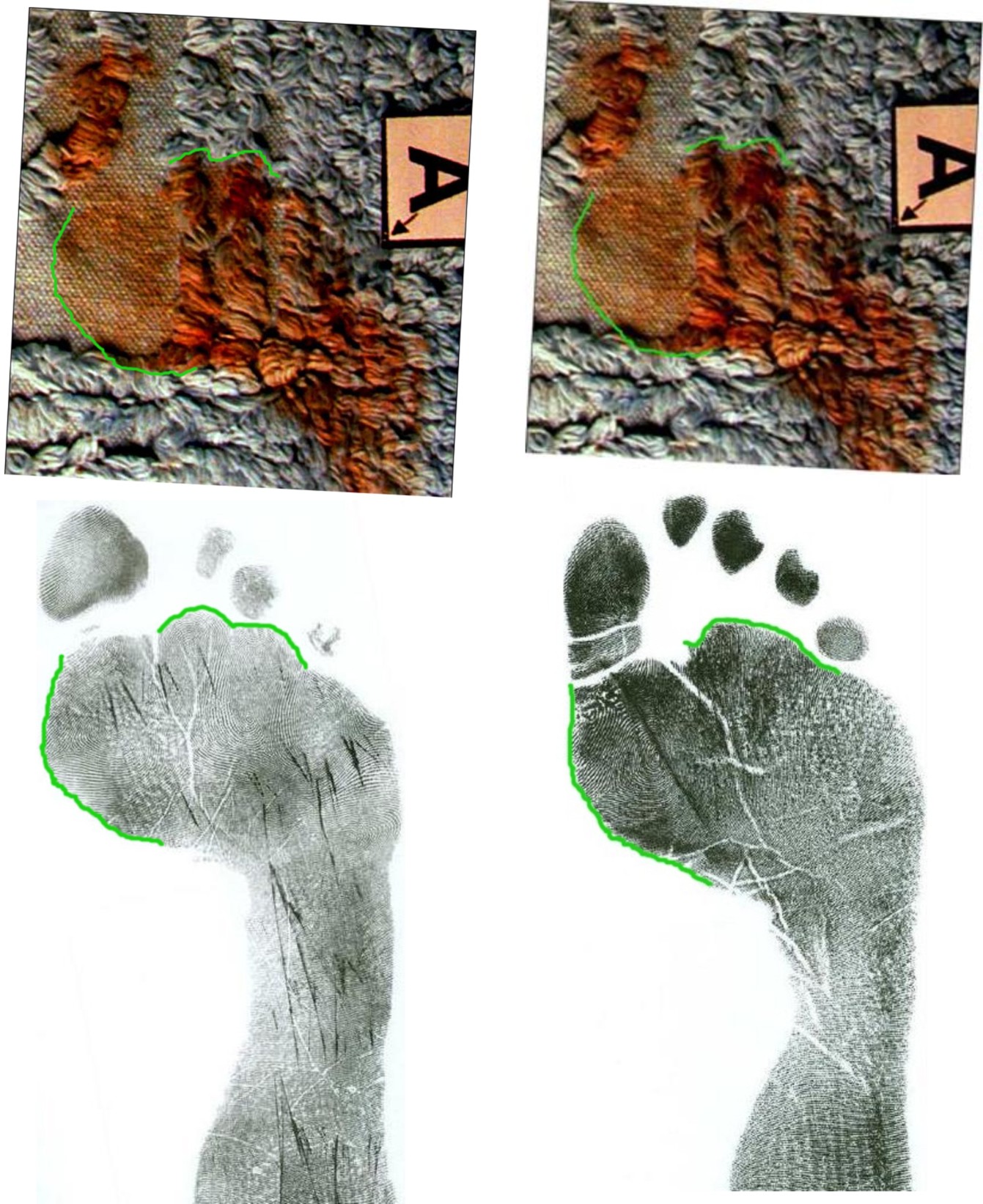
Curvatures of plantar arch are very different
The plantar arch curvature, highlighted in two different drawings (the second highlights also the upper outline “hunches”); the plantar arches in the two sample prints of Sollecito and Guede are shown below. The curvatures of plantar arch are very different.
26. The outline curvature generates different angles
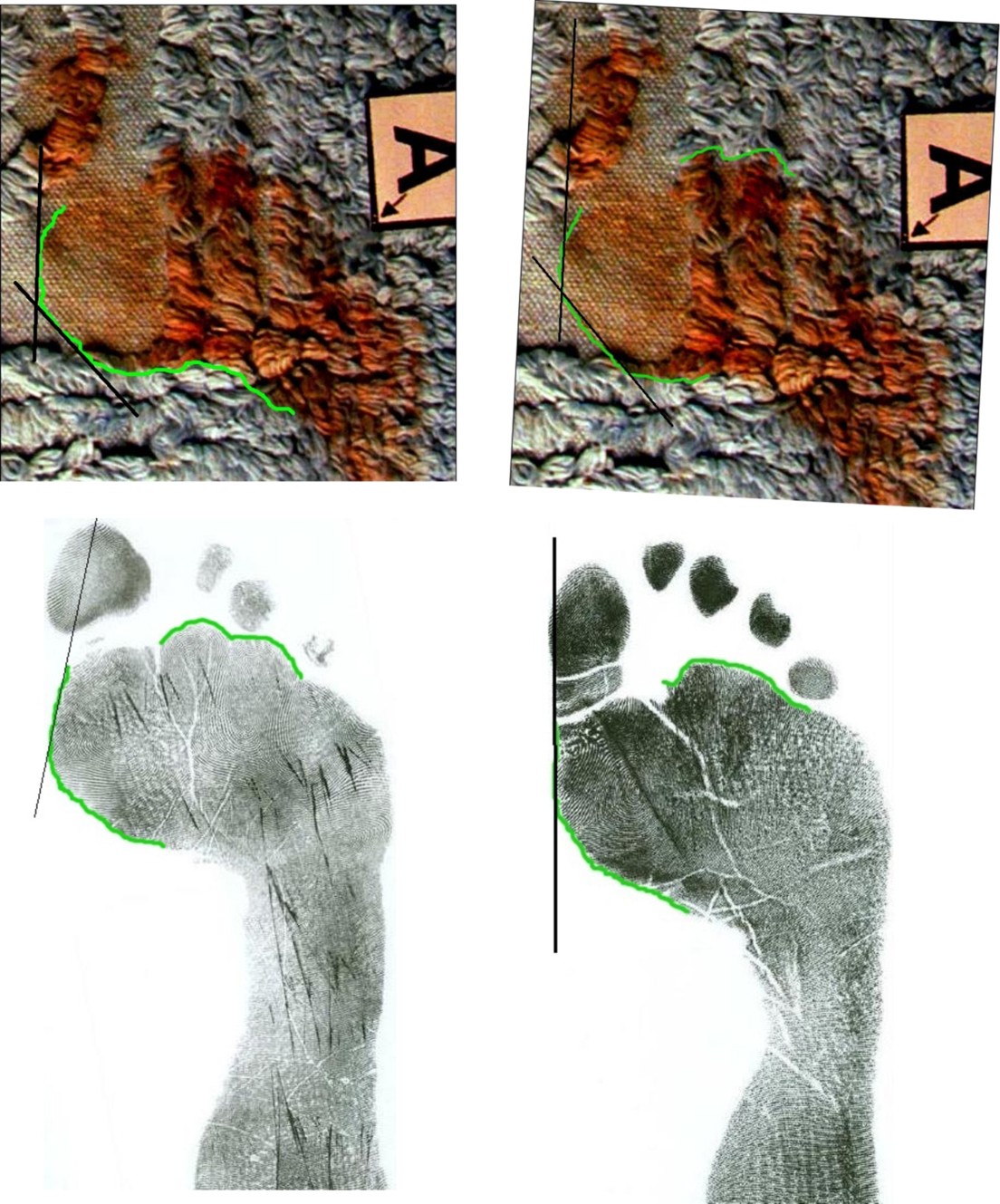
Sollecito’s and Guede’s plantar arch curvatures have very different angles. Also the left outline of metatarsus maintains a different curvature. Sollecito’s outline has an angle (see outline tangent) intersecting the toe (the metatarsus has a “bunion”); in Guede’s print there is basically no intersection, the outline and the toe form almost a straight line.
27 . Plantar arch curvature angle differs between Sollecito and Guede
If you consider the vertical axis of the sample footprint, and its orthogonal line, you may notice how the plantar arch curvatures of the two prints accomplish different angles: the two angles are VERY different, not just three or four degrees.
The (too) narrow angle of Sollecito’s plantar arch probably has a relation with the protruding outline and angle seen in pic 26., and seems related to a hallux valgus (which Guede does not have).
28 . The “cleft” on the left side of the stain
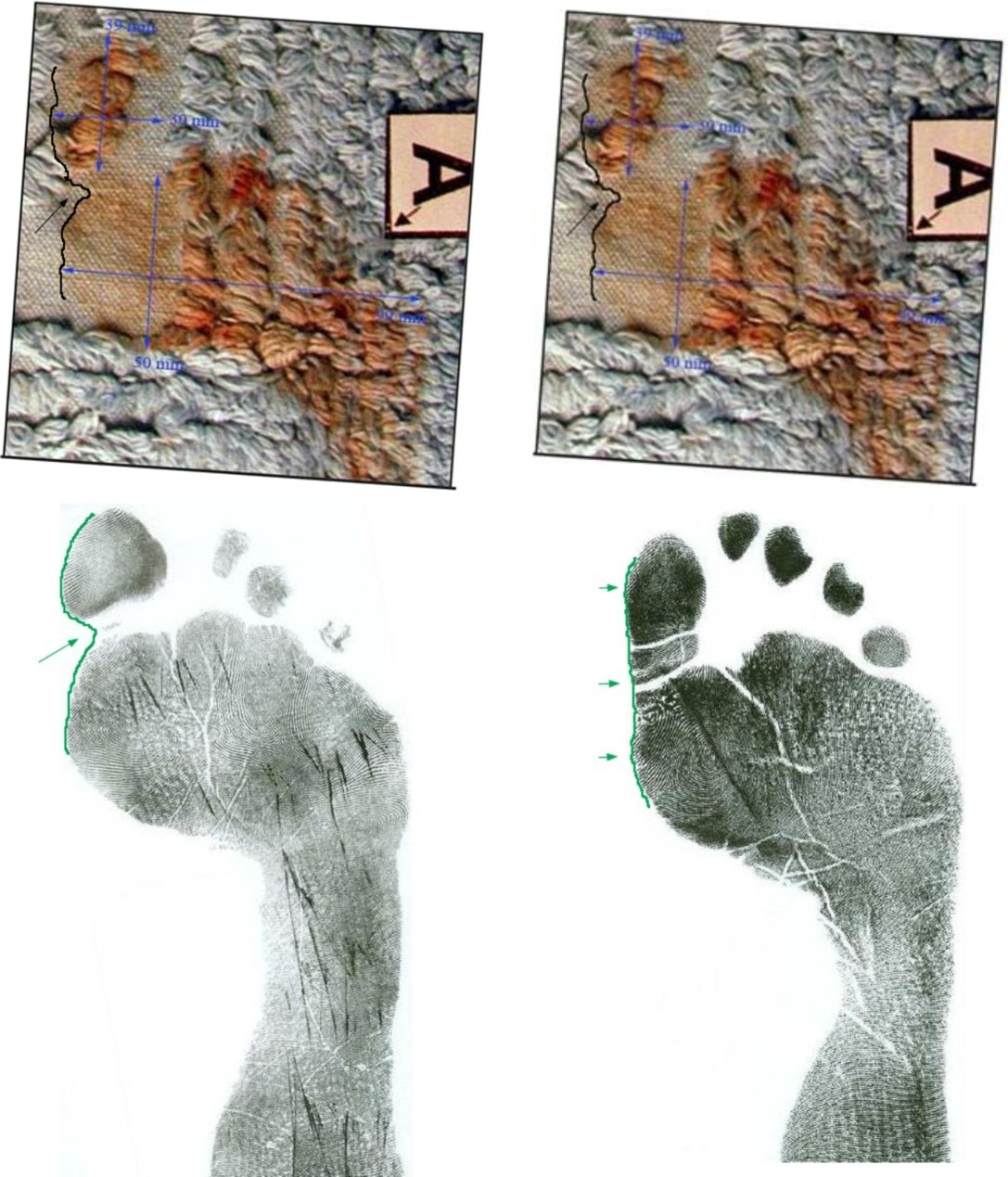
The “cleft” on the left side
This has a correspondence with one sample print, not so with the other.
29 . Table of metric comparison (by SomeAlibi)
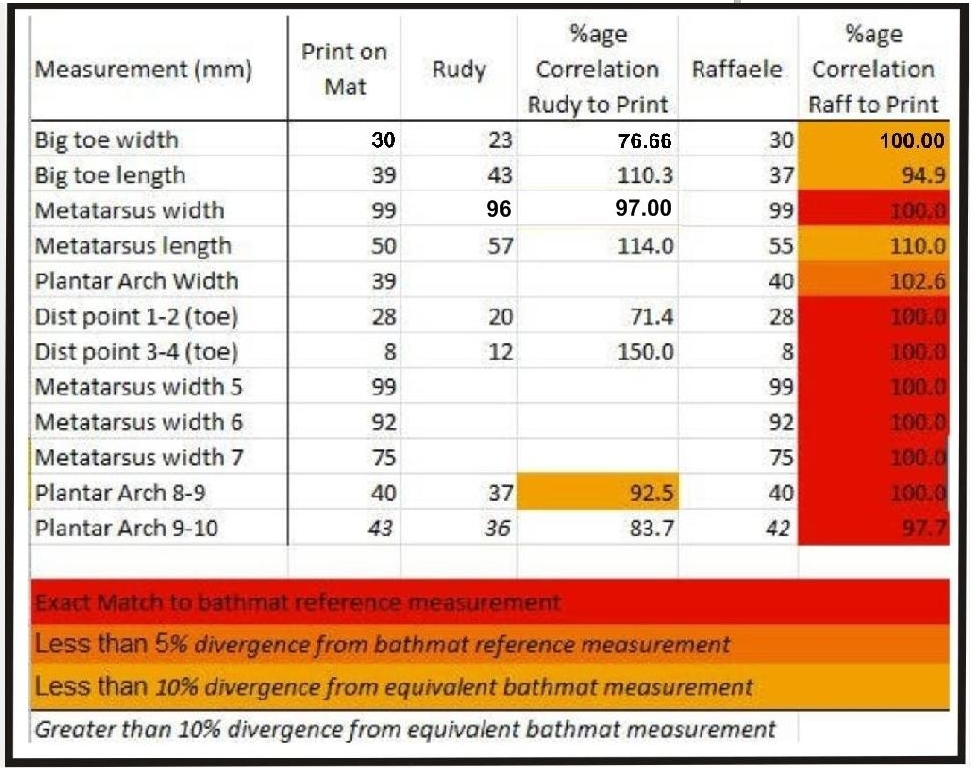
SomeAlibi’s post of a year ago
Comparison of measurements and analysis of correspondence degree of bathmat print, with both Guede’s and Sollecito’s sample prints.
Thursday, April 10, 2014
Sollecito Takes On A New Lawyer To Help Him Work His Way Past The Minefield That Is His Book
Posted by Peter Quennell
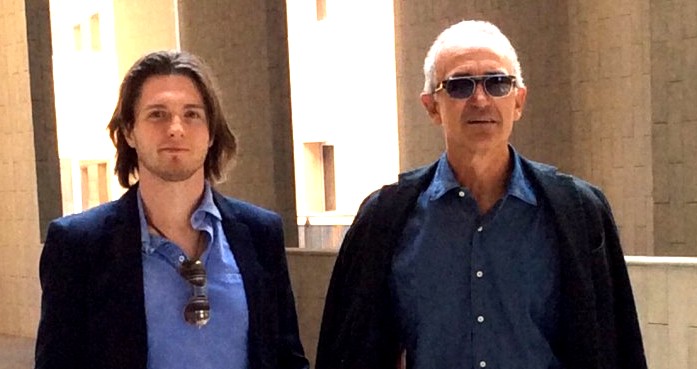
Raffaele Sollecito retained Alfredo Brizioli after he burned his trial lawyers in his book
Both Sollecito’s book and Knox’s book seem to have the primary purpose of poisoning public opinion against the courts.
The serious charges Sollecito and Knox will probably face for those books are of three kinds: (1) the contempt-of-court misrepresentation of the Italian justice system itself; (2) the obstruction-of-justice twisting of the evidence in the case; and (3) the claims of crimes committed by numerous career police and prosecution officials.
If false, in effect a gigantic frame-up that leaves Knox’s framing of Patrick in the dust.
At the eighth session of the Florence appeal court back in January, Giulia Bongiorno engaged in a day-long summation which was peculiar, to say the least.
Like Sollecito and Knox in their books, Giulia Bongiorno seemed to be attempting to put the justice system and investigation and prosecution in the dock.
If false, another gigantic frame-up that leaves Knox’s framing of Patrick in the dust.
Bongiorno’s rant didnt seem to help Sollecito in undermining any of the hard evidence in the case, and it left the judges visibly unmoved. But it was notable how closely it resembled the rants on the justice system and its officials by Sollecito himself in his book. See the examples in the post below.
There are some complex later passages in Sollecito’s book and some recurring themes that we will analyse which would seem impossible for Sollecito to write about in such detail without the extensive help of a lawyer who was in the court.
Who precisely was that?
Reports from Italy now state that Alfredo Brizioli, not Giulia Bongiorno, will be the lawyer the Sollecitos choose to respond to the investigating prosecutor’s report on the book. Perhaps Mr Brizioli (who right now is himself on trial for obstruction of justice in another case) can try to negotiate a way for his client to spread the blame before the charges are set in stone.
The Sollecitos seem weak. Alfredo Brizioli seems weak. Giulia Bongiorno seems weak. And Knox also seems weak - if Sollecito is ever going to back away from Knox (perhaps to try to claim the final murderous stab of Meredith was solely Knox’s crazed idea) there is just this one last chance.
We in no way favor Sollecito getting off lightly without recanting. We do want to point to the potential fireworks a smart prosecution has engineered that might help achieve this.
Although there was a sort of bidding war for both books, not every publisher, having seen what was to be in them, was eager to join in. Some did sit on the sidelines.
Withdrawing the two books ASAP might be the smart move. The mood in the book industry in New York, where both publishers have their HQ’s, seems to be that that move could be the wisest.
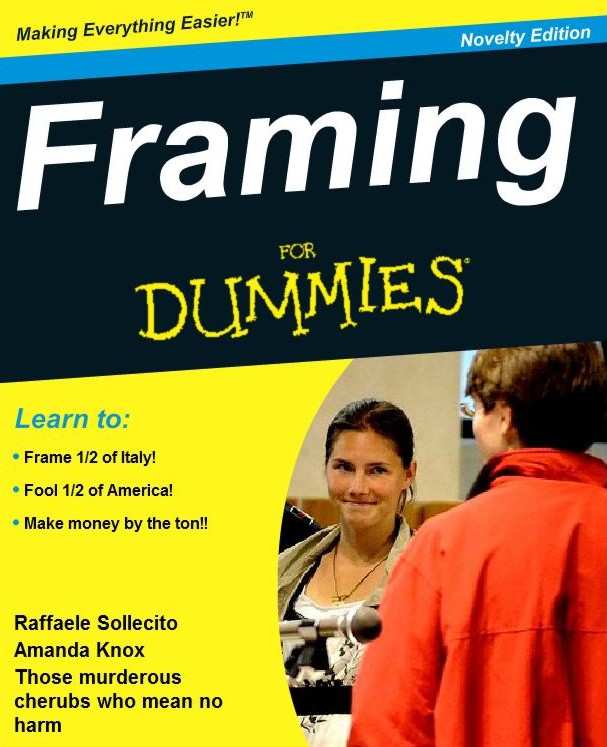
Monday, April 07, 2014
Italy Pushes Back On False Claims In Sollecito Book: 20 Examples Of What He Must Defend In Court
Posted by Our Main Posters
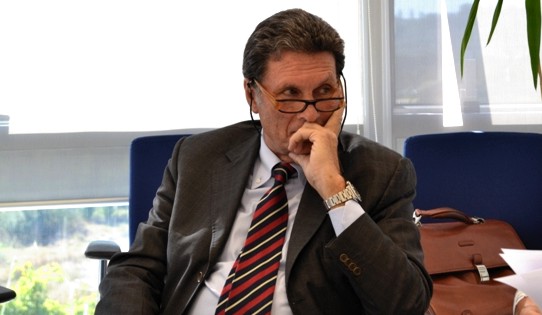
[Florence prosecutor Gianbartolomei will announce RS charges later this month]
Many posters contributed to this analysis and to what is to come. Special thanks to James Raper and Sara, and also to Vivianna, Yummi and Kermit.
1. Sollecito’s blood-money book gets published
Sollecito’s hapless book Honor Bound was released in English on 18 September 2012.
Within ten days all of Italy knew that the book was a crock.
Bruno Vespa, the persistent host of Porta a Porta, Italy’s most popular crime show (for the equivalent of which American TV cries out) forced Sollecito’s father in national prime-time to admit that at the core of the book was a huge lie.
Other claims about the case and the officials were shown to be wrong too.
Smarter people than Sollecito’s help in the US (Andrew Gumbel and Sharlene Martin, later John Q Kelly, and Simon & Schuster) might have put the brakes on until they got the truth straight and a revised version out.
But no, a media blitz was all ready to roar. The blood-money couldn’t wait.
Huge numbers of professional book reviews and Amazon reader reviews swallowed Sollecito’s claims in the book whole. The nastiness toward Italy and its justice system and officials was ratcheted onto a whole new plane.
2. Needless to say, official Italy did take note
For the legal reasons explained in this key post an investigation by the Florence Chief Prosecutor’s Office was mandated to begin.
In that same post it was warned that for the period the investigation would require, it would be taken below the radar, so that the Sollecito defense team would have no way to respond through dishonest PR or legal dirty tricks.
A not-unsurprising result of that stealth move was that in the meantime, in the last year, very full of themselves and feeling no constraint, Sollecito and his team went hog-wild in adding more crazy claims. And still more.
3. Now the investigation is complete
Now Prosecutor Gianbartolomei has issued his announcement of the conclusion of his investigation. The content of the notice is at present confidential except to the defenses.
As Yummi reports, from this point on, the defense has 20 days to say something, such as to request that Sollecito be interrogated or allowed to declare or explain something.
Then the prosecution will file charges against Sollecito and Gumbel, and possibly Sharlene Martin and Simon & Schuster, their careless publishers in New York.
Which precise false claims Prosecutor Gianbartolomei has made the target of his report we do not know. But this is a target-rich environment, that is for sure:
Consider for starters these 20 false claims which, believe it or not, all appear in the first seven pages of the book.
4. Twenty False Sollecito Claims
1. That Italian justice authorities took the easy way out
This is the story of two ordinary people who stumbled upon an extraordinary circumstance, the brutal murder of a British student in Italy. Neither Amanda Knox nor I had anything to do with the crime, but we came perilously close to spending the rest of our lives in prison because the authorities found it easier, and more convenient, to take advantage of our youth and inexperience than to mount a proper investigation. It’s that simple. And that absurd.
No advantage was taken of them. The two stood out very sharply from all the others of similar age, and of similar inexperience (whatever that means). They did and said dozens of things in the early days that set them sharply apart.
They were interrogated quite fairly, the Italian media was not especially hard, Dr Mignini never ever leaked, and they had lawyers and family handy at every turn after they were arrested. They each gave the authorities less than zero help - they tried to lead them off on wild goose chases, for example the false claim AK made against Patrick and dozens of other false claims, and apparently tried to finger yet another north African, Hicham Khiri, in a conversation they clearly knew was being recorded.
A “proper” investigation was indeed done. Simply read through all the posts on the trial here in the first half of 2009, and the prosecutor’s excellent summations, and you will see what a smooth comprehensive job was done. And the Supreme Court concluded that THREE had to have been involved, from the recreation of the attack and all the wounds on Meredith’s body. AK and RS and their lawyers never came within light-years of throwing real suspicion on anyone else.
2. That the preventive custody was very harsh
On November 1, 2007, Amanda and I were carefree students at the beginning of a cross-cultural love affair in a beautiful Umbrian hill town. Within days, we were thrown into solitary confinement in a filthy prison, without access to lawyers or loved ones, accused of acts so heinous and disturbing we may never be able to banish them from our thoughts, or our nightmares.
Raffaele was sent to preventative prison on Tuesday November 6. Capanne Prison was almost brand-new then, and far from crowded. Cells contain TVs and private bathrooms.
All questioning had been stopped early on 6 November until Sollecito could have a lawyer present. He himself wrote to his father in his “prison diary” on November 7: “I may see you tomorrow, at least that is what I was told by Tiziano [Tiziano Tedeschi, his lawyer at the time], who I saw today and who defended me before the judge.”
Mr Tedeschi made no complaint about any delay in the first meeting with his new client. In Italy, a judge must determine within 48 hours whether to hold or release detained suspects. Judge Matteini did so meticulously and refused his release.
3. That the prosecution and Italian media demonized the pair
In the newspapers and on the nightly news, we were turned into monsters, grotesque distortions of our true selves. It did not matter how thin the evidence was, or how quickly it became apparent that the culprit was someone else entirely. Our guilt was presumed, and everything the prosecution did and fed to the media stemmed from that false premise.
In the real world, the prosecution fed nothing at all secretly to the media and publicly very little, none of it self-servingly biased. Italian reporting was sporadic and very mild compared to anything one can see said daily about possible perps in the US and UK newspapers and on US TV. Besides, any coverage, which was in part deliberate in the situation as dozens of students were fleeing Perugia, had no influence on anything, neither on the investigation nor the trial.
The Italian system is set up so media can have less influence than almost any other media on any other justice system in the world. The Micheli and Massei sentencing reports show the judges were not unduly influenced even by the lawyers right in front of them, let alone by mild media reports 1 or 2 years before that.
4. That four years were wasted showing where the prosecution went wrong.
By the time we had dismantled the case and demonstrated its breathtaking absurdity [in the annulled Hellmann appeal] we had spent four of what should have been the best years of our lives behind bars.
“We” meaning the defense lawyers did very little in the annulled Hellmann appeal that they hadn’t flailed uselessly against in the trial. Except of course maybe shopping for an inexperience and pliable judge, and for DNA consultants who they could then spoon-feed. Much of the hard evidence they simply kept well away from in the trial and annulled appeal. Such as the extensive evidence in the corridor and bathroom and Filomena’s room, which were all considered parts of the crime scene.
On the other hand, RS’s claim could well apply to what Dr Galati and Cassation did for the Hellman sentencing report. Dismantled the appeal verdict, and demonstrated its breathtaking absurdity.
5. That Knox was made a target because timid Italy was scared of her.
Amanda and I certainly made our share of mistakes. At the beginning we were too trusting, spoke too frivolously and too soon, and remained oblivious to the danger we were courting even after the judicial noose began to tighten. Amanda behaved in ways that were culturally baffling to many Italians and attracted a torrent of gossip and criticism.
An inaccurate and xenophobic remark originated by the American Nina Burleigh, who was having severe culture shock of her own and surrounded only by other foreigners with similar mindsets. What EXACTLY was so baffling about Knox to the very hip Italians? That Knox was pushy, obnoxious, humorless, rather lazy, rather grubby, and not especially bright or funny or pretty? That she put off Patrick, Meredith, her other flatmates, the boys downstairs, the customers in the bar, and just about everybody else except for the distasteful druggie loner Sollecito?
Read this post by the Italian-American Nicki in Milan. To quote from it “As many of us were expecting, Amanda’s testimony has backfired. She came across not as confident but arrogant, not as sweet but testy, not as true but a fake who has memorized a script, an actress who is playing a part but not well enough to fool the public….. Amanda Knox is not on trial because she is American and therefore too “emancipated”....Italians don’t much like Amanda primarily because they perceive her as a manipulative liar, who is suspected of having committed a heinous crime for which there is a whole stack of evidence.”
6. That Knox and Meredith were really great, great friends.
We were young and naive, unthinking and a little reckless. Of that much we were guilty. But what we did not do””and could not have done, as the evidence clearly showed””was murder Meredith Kercher.
Meredith was Amanda’s friend, a fellow English speaker in the house they shared with two Italian women just outside Perugia’s ancient city walls. She was twenty-one years old, intelligent, and beautiful. She and Amanda knew each other for a little over three weeks, long enough to feel their way into their new surroundings and appreciate each other’s interests and temperaments. I never heard about a single tense moment between them.
Plenty of other people did know of tensions. Meredith’s family and friends all knew Meredith was finding the noisy dirty lazy loud unfocused Knox and her one-night-stands hard to take. Her other flatmates found her hard to take. Her employer Patrick found her hard to take. His customers in the bar found her hard to take. The Lifetime movie got this strident angle pretty straight.
Remember, Meredith enrolled for a full academic load at the main university. Knox in sharp contrast took only one undemanding language course - which anyone could walk into - requiring maybe 10 hours of study a week. They increasingly did less together. In fact after several weeks nobody was lining up to have anything to do with Amanda Knox.
Seemingly unable to reverse herself, she was headed to being among the least popular of students in Perugia. It should be recalled that the callous remarks by Amanda Knox about the death of her so-called friend Meredith included “Shit happens”, “She fucking bled to death”, and “‘I want to get on with the rest of my life”.
7. That an intruder knew about the rent money and so murder ensued.
Meredith, of course, suffered infinitely worse luck than we did: she came home, alone, on an ordinary Thursday night and had her throat slit by an intruder hoping to steal the household rent money.
There is zero evidence that this was the case. Knox herself ended up with a similar amount of cash that she has never been able to explain. There is zero possibility that Guede would know that any money was lying around - or not lying around, as it was concealed in Meredith’s drawer.
And take a look at the many images of the brightly lit house at night. There are several dozen other houses behind it in the dark which any smart burglar would have chosen first. In 2008 two real break-ins occurred at the house - both were in the dark behind the house, which is by far the easiest place to break in.
So much for the spurious lone-wolf theory, which Judge Micheli first ruled out even before trial.
8. That the media got hysterical and portrayed heartless killers.
But the roles could easily have been reversed. If Meredith’s Italian boyfriend had not gone away for the weekend and if Amanda had not started sleeping over at my house, she””not Meredith””might have been the one found in a pool of blood on her bedroom floor. That reality was quickly lost amid the hysteria of the media coverage. But it continued to hover over both of us””Amanda especially””as we sank into the legal quagmire and struggled in vain to overcome the public image of us as heartless killers.
There was zero media hysteria. This silly claim was addressed above. Watch the Porta a Porta YouTubes and dozens of other Italian reports and try to find ONE that is not fair and cautious and mature.
How precisely did the two struggle in vain to overcome their public image? By coming up repeatedly with stories which didnt even tally with others of their own, let alone with one another’s? They never between them made even one helpful statement which actually helped the police. And even their respective parents strongly suspected or knew of their guilt and were all caught incriminatingly on tape.
9. That Rudy Guede did it alone; ignore vast evidence that proves not.
This should not have been a complicated case. The intruder was quickly identified as Rudy Guede, an African immigrant living in Perugia with a history of break-ins and petty crimes. His DNA was found all over Meredith’s room, and footprints made in her blood were found to match his shoes. Everything at the crime scene pointed to a lone assailant, and a single weapon. Guede repeatedly broke into houses by throwing a rock through a window, as happened here, and he had been caught by the authorities in the past with a knife similar to the one that inflicted Meredith’s fatal wounds.
This is laughable. It has in fact been demonstrated in numerous ways that the attack involved multiple assailants and this was accepted by the Supreme Court.
Sollecito’s own lawyers never forcefully argued this. They produced two non-credible witnesses in the appeal trial (Alessi and Aviello) to actually prove that Guede had some other accomplices or that several others did it. Also Amanda Knox if anything diverted attention AWAY from Guede as he did in turn from her. He wasn’t quickly identified precisely because Knox had rather credibly fingered Patrick.
There is no proof Guede was an intruder. The trial court concluded Knox invited him in. Guede had zero proven history of break-ins or petty crimes or drug-dealing, and late in 2008 at his trial Judge Micheli became angry at such claims. Guede had no prior criminal record at all. He had only been back in Perugia for a few weeks, after an extended stay up north. His DNA was not found “all over” Meredith’s room. A major surprise, in fact, was how few traces of him were found.
The recreation of the crime scene and the autopsy both pointed AWAY FROM a lone assailant, not toward. From Meredith’s wounds, it was quite evident that two and perhaps three knives had been used, and not a single weapon. What lone intruder carries or uses two or three knives? And footprints in blood outside the door matched the feet of both RS and AK. This is why the Supreme Court confirmed Guede’s guilt only “in concorso” (with others).
10. That the cops could have caught Guede fast, despite Knox’s frame
Guede did not call the police, as Amanda and I did, or volunteer information, or agree to hours of questioning whenever asked. Rather, he fled to Germany as soon as the investigation began and stayed there until his arrest two and a half weeks later.
Guede’s apprehension and eventual conviction on murder charges should have been the end of the story. But by the time Guede was identified, the police and the public prosecutor’s office had convinced themselves that the murder was, incredibly, the result of a sexual orgy gone wrong, in which Amanda and I had played leading roles. Their speculations ignited a media firestorm, inspiring sensationalist headlines across the world about the evil lurking behind our seemingly innocent faces.
The authorities had no shred of evidence to substantiate this story line, only erroneous suppositions and wild imaginings. We had an alibi for the most likely time of death, and none of the initial forensic evidence tied us to the scene of the crime. Nothing in our backgrounds gave any hint of a propensity for violence or criminality. We were both accomplished, hardworking students known to our friends and families for our gentleness and even tempers.
Four more untrue remarks. All three were convicted of a murder with a sex-crime element and nobody was wrongly “convinced”. Which alibi is Sollecito talking about now? He himself admits in chapter 1 (Love and Death) that they had no “real alibi”. They still have no alibis at all for the second half of the evening, neither of them, when Meredith’s murder indisputably occurred.
Extensive forensic evidence within days tied them both to the scene. Not a single element of it has been discredited in the eyes of the Massei trial and Nencini appeal court. Not even one. Nothing was falsified.
Neither of their backgrounds was squeaky clean. Both had long been into illegal drugs, the loner Sollecito had to be watched by his father and teachers, the increasingly disliked Knox had a history of doing and saying crass off-putting things. Both were lagging behind their brighter peers in their studies and Knox was taking a year off.
11. That the prosecution fed the media a huge number of false claims.
Yet the authorities stuck to their guns. They fed the media a steady diet of sensationalist stories of how Amanda, the promiscuous American she-devil, and I, her sex-and-drug-addled Italian helpmeet, had tried without success to drag Meredith into our depravity and punished her by plunging an outsize kitchen knife into her neck.
Complete fiction. Again, in the real world, as the media reporters all confirm, the prosecution fed nothing at all secretly to the media, and publicly very little, none of it self-servingly biased.
Italian reporting was sporadic and very mild compared to anything one can see daily on possible perps in the US and UK newspapers and on US TV crime shows. There is zero sign this mild coverage mattered to the courts. As the media reporters all confirm, they were fed next to nothing by the police or prosecution on the case,
But whereas Mr Mignini famously never leaks, the defenses are widely claimed to have leaked throughout like sieves. So did Sollecito’s own family - they leaked an evidence video to Telenorba TV, for which they were considered for trial. Even we at TJMK and PMF received several offers of juicy leaks. Here is one example of where the Knox forces leaked - wrongly in fact - and then nastily slimed the prosecution and defenseless prison staff.
12. That the authorities had lots and lots and lots of scenarios.
It might have been funny if the consequences had not been so devastating. Listening to the tortured language of the prosecution””“one can hypothesize that . . . ,” “it is possible that . . . ,” “one can imagine that . . . ,” “this scenario is not incompatible with . . .”””it became clear that the authorities, like the media, were treating our case with the bizarre levity of an after-dinner game of Clue, or an Agatha Christie mystery. Everyone, even the judges in their black robes, had theories they were itching to air.
Have Sollecito and Gumbel ever before been in any other court in Italy or the UK or the US? Every judge and/or jury has to arrive at a scenario on lines not unlike this. That is the whole POINT of having courts - to weight the probabilities in what happened in the crime. The only difference in Italy is that the judges have to think their verdict through for weeks, and then write it all out, and then see it scrutinized by a higher court. This is hardly a requirement to be sneered at.
Gumble and Sollecito should have studied how US and UK juries arrive at their own scenarios. Very few US and UK lawyers think they do a better job. Ask those who watched the OJ Simpson and Casey Anthony trials and bitterly criticised the outcomes. And Italy has a vastly lower rate of false imprisonment than the US does.
13. That Italy is a medieval country with a primitive justice system.
It could have been Colonel Mustard in the drawing room with the revolver; instead it was Amanda and Raffaele in the bedroom with the kitchen knife. How was it conceivable that a democratic country known for its style and beauty and effortless charm””the Italy of the Renaissance and la dolce vita””could allow two young people to be catapulted to international notoriety and convicted of a horrific crime on the basis of nothing at all?
This is not remotely what happened. There was very far from nothing at all. Convictions in the US and UK regularly result based on evidence 1/10 or 1/100 of that here - sometimes from one single evidence point. Any one or several of maybe 100 evidence points here could have convicted them in a US or UK court.
Italy gives defendants every possible break, and the justice system is seriously loaded against victims and their families. Read here and here.
14. That the prosecutors office and media were in a grim embrace.
The answer has something to do with the grim embrace that developed between the prosecutor’s office and the sensationalist media. Like addicts constantly looking for the next fix, each fed the other’s insatiable appetite for titillation and attention. The casual cruelty of “Foxy Knoxy” and her Italian lover became too good a story line to abandon, even when it became apparent it was overheated and unsustainable. Our suffering was the price to be paid for the world’s continuing entertainment.
WHAT grim embrace? WHAT addicts? WHAT fix? WHAT insatiable appetite? WHAT titillation and attention? This is clearly defamatory if it can’t be proven, and we can turn up no evidence that any of it is true. It has to be one of the most foolish lies in the entire book, it is so easy to disprove. These who are being accused of crimes here are career police and prosecutors secure in their jobs, and none have the slightest gain to make from false convictions.
15. That in the justice system speculation and hearsay run rampant
The meandering complexities of the Italian legal system, where speculation and hearsay are allowed to run rampant and time invariably slows to a maddening trickle, did little to help our cause.
Total mischaracterization. First note that by comparison with any country in the world THERE IS NOT MUCH CRIME IN ITALY. There is some minor corruption and still some minor mafia action, but thefts and burglaries and assaults are few and murders even fewer. The main crime if you can call it such is not lining up to pay taxes. Italy’s murder rate is 1/6 that of the United States and its prison incarceration rate is 1/30 that of the United States, so where IS all this crime about which the claimed speculation and hearsay are running rampant?
The legal process could have been fully over by the end of 2009 if (1) there was not the entitlement to two automatic appeals; in UK and US terms there was very little to appeal about; and (2) the Hellmann appeal court had not been fixed to produce a corrupt outcome, as the displaced judge Sergio Matteini Chiari and Cassation and the Council of Magistrates have all made plain.
And compared to American police and prosecutors, their Italian counterparts are famously taciturn under their unusually firm rules. There is media interest, for sure, as there should be when there are crimes, but that also is comparatively restrained. Watch the various Porta a Porta shows on YouTube and you will see how sedate crime discussion tends to be.
The Constitution and judicial code set out to achieve the exact opposite of speculation and hearsay affecting justice, and they do so. Creating this restraint is a primary reason for the judges’ sentencing reports and all the magistrates’ checks of investigations along the way.
This whole series of dishonest claims about the the Italian system in the preface of the book and in a later chapter have clearly not been read through or okayed by even a single Italian lawyer.
16. That in Italy proof beyond a reasonable doubt scarcely exists
For reasons deeply embedded in the country’s history, the concept of proof beyond a reasonable doubt scarcely exists in Italy, and the very notion of undisputed fact is viewed with suspicion, if not outright aversion.
So Gumbel and Sollecito are historians and legal experts now? It would be nice, wouldn’t it, if either were able to explain the remark. This may be an ignorant swipe at the Napoleonic Code on which the law of a lot of continental Europe is based. Ignored is that Italy carried out its own reforms to the Code in 1990 and more subsequently. Much of that reform, it should be pointed out, was procedural or structural rather than substantive law.
There are two things wrong with “..the concept of reasonable doubt scarcely exists in Italy.”
1. It is factually wrong. Italian jurists, the courts, and so on, are well acquainted with the concept as it has been a fundamental aspect of criminal proceedings in Italy as elsewhere for many decades if not centuries.
2. It suggests that Italians are not intelligent enough to understand the concept anyway. That of course is an insult to Italians. Actually they are no less intelligent than the rest of us elsewhere who strive to understand it.
Until the 1990 Reforms the relationship between criminal and civil proceedings in Italy were governed by the principles of unity of jurisdiction and the prevailing status of criminal proceedings. Hence, if the facts were the same then criminal proceedings (to punish the guilty) and civil proceedings (to render liable the guilty for damages) were heard at the same time and still sometimes are, as in the Meredith Kercher case.
What has changed (relevant to the above quote) is that civil cases can be and are more likely to be heard independently from the related criminal cases and, where not, the standard of proof in civil cases (the preponderance of evidence or, as we usually refer to it, the balance of probabilities) is to be applied to the civil case, and the civil case only, rather than be confused with or overriden by the criminal standard of proof (beyond reasonable doubt).
Not an easy task, admittedly, to apply different standards to different tasks, based on the same facts, in the same proceedings, but Italian judges are trained to do this because that is their system. No judge would EVER confuse “beyond reasonable doubt” with “the balance of probabilities” when the issue at stake is depriving an individual of his freedom.
17. That the Italian judiciary has vast, unfettered powers
Few in Italian society wield as much unfettered power as the robed members of the judiciary, whose independence makes them answerable to nobody but themselves.
Radically the opposite of the truth. The paranoid claim reads like it came from ex PM Berlusconi fearful of his own conviction or one of his parliamentary lackeys such as Girlanda.
The checks and balances on judges in the Italian system are enormous, perhaps the toughest checks and balances in the world. Read here and here about them.
All of the best judges in the world are independent and they all follow a demanding career path, not elected (as ex-Judge Heavey was) under zero criteria, or appointed under the political sway of politicians. We wonder if Gumbel and Sollecito have ever heard of the US Supreme Court? Do those judges answer to anybody? No? How unfettered.
18. That the courts are the most reviled institution in Italy.
Many Italians retain a healthy skepticism about the reliability of their procedures and rulings. The courts””tainted by politics, clubbishness, pomposity, and excruciating delays””are the most reviled institution in the country.
As our Sollecito Book pages make clear again and again and again, the Italian system is remarkably NOT tainted by politics, as even the most surperficial watcher of the trials of ex Prime Minister Sylvio Berlusconi would know.
And on the issue of popularity we have previously posted this and this and also this.
Our Italian poster Machiavelli (Yummi), who posted our deep analysis of the appeal to the Supreme Court by Dr Galati, has provided these hard facts:
For comparison, in 2011 the percentage of Italians who declared they trust the justice system “a lot” or “enough” was 53.3%. By comparison, the percentage of Italians who declared they trust the government “a lot” or “enough” were 14.7%, and those who trust the parliament were only 15%.
In 2012, the percentage of Italians who trust the parliament is now only 9.5%, and those who trust the Mario Monti administration are only 21.1%.
Over the eight years from 2004 to 2012 the percentage of Italians who trust the justice system was always bigger than those who trust parliament or government by at least ten points, and in some years we can see a spread of 20, 30, even 39 percentage points achieved by the judiciary over the parliament and government.
However, some cases of corruption (such as our Hellmann-Zanetti case, but also several others indicated by the Rapporto Italia 2012) do hamper trust.
The most trusted institutions in Italy above all are the Carabinieri (74% of Italians trust them) and the Polizia di Stato (71%).
Which means the most trusted institutions are precisely those law enforcement instruments which are deployed to enforce the orders of prosecutors.
19. That prosecutors can spin their cases into any shape they please.
Because the Italian legal system is almost completely blind to precedent and relies on a tangle of impenetrable codes and procedures, prosecutors and judges have almost boundless freedom to spin their cases into any shape they please and create legal justifications on the fly. Often, they are more interested in constructing compelling narratives than in building up the evidence piece by piece, a task considered too prosaic and painstaking to be really interesting.
Whoever wrote this either wasnt an Italian or a lawyer, and either way didnt have much of a clue. The entire Italian system under the post WWII constitution was designed to PREVENT what Sollecito & Gumbel claim it allows here.
There are checks and balances and reviews every step of the way. Magistrates (initially Matteini here) determine what a prosecutor may do in developing and presenting a case. Parties may appeal to the Supreme Court AT ANY TIME as Knox’s lawyers did over her second written confession - which she herself had demanded to make in front of Dr Mignini after he finished warning her of her rights.
Hard for Sollecito & Gumbel to believe, perhaps, but the defense is actually present in the same courtroom. They can raise points of order at any time. So can the defendants themselves, at any time, something maybe unique in the world.
And judges actually have minds of their own. And then there are the unique written sentencing reports, and the two automatic appeals if any parties want to pursue them.
Sollecito & Gumbel should have read the 2012 Galati appeal more closely. The Prosecution’s Appeal To The Supreme Court is available in English here. Precedent has a section to itself - “The non-observance of the principles of law dictated by the Cassation Court in the matter of circumstantial cases (Article 606(b)) in relation to Article 192 paragraph 2 Criminal Procedure Code.”
Well, that’s precedent, via the Court of Cassation no less! How surprising from Gumbel/Sollecito that they should make that claim about ignoring precedent when in fact there it is, going right to the heart of the flawed Hellmann/Zanetti judgement on circumstantial evidence! What else is a Code but in effect a codification, a gathering together, a rationalisation, of best law - and precedent?
There is an absurd irony here, were they aware of it. Perhaps they are. Surely it is Hellmann and Zanetti who have displayed “a boundless freedom” in spinning the case “into any shape they please”, and who have “created legal justifications on the fly”? As for prosecutors doing this, at least Dr Mignini followed the evidence, and American readers may recall the infamous Jim Garrison, the DA hero of Oliver Stone’s movie “JFK” but who in reality, unlike Dr Mignini, was a total and utter crackpot.
And what issue exploded the Porta a Porta TV show in Italy in September 2012? It was Sollecito’s false claim that the prosecution had secretly tried to offer him a deal if he would roll over on Knox. NOBODY including his own father and his own lawyers confirmed him. Evidence against both was overwhelming. Nobody needed such a deal, and Italian prosecutors are highly rules-bound against ever offering such deals.
Sollecito was in effect accusing Dr Mignini of a felony with this much-repeated false claim in his book. (In her book Knox also accused Dr Mignini of a felony.)
20. That the prosecutors and judges in Italy are far too close.
Prosecutors and judges are not independent of each other, as they are in Britain or the United States, but belong to the same professional body of magistrates. So a certain coziness between them is inevitable, especially in smaller jurisdictions like Perugia.
Yes, prosecutors and judges in Italy belong to the same professional body of magistrates. But then so does the defense lawyer Ms Bongiorno. The claim that there is no independence between prosecutors and judges in Italy, in fact a coziness between them, is a bit rich.
Consider, say, the UK. It is true cases are prosecuted by the Crown Prosecution Service, a government body, but in serious cases the CPS will employ barristers from the Inns of Court. There is scarcely a judge in the UK, even up to the highest level, who was not and who is not still a member of one of the Inns of Court from whence barristers, for the prosecution or for the defence, ply their trade.
You can’t walk past an Inn without seeing the names of judges on the roll call on the plaques outside. A judge is still a barrister, just fulfilling a different function, although, of course, now paid by the State. The old school boy tie? Corruption? No, the fulfilling of different roles by members of the same body is called professionalism.
Judges and lawyers all belong to the American Bar Association in the US and attend the same conferences. No sign that this lack of “independence” ever affects trials. This claimed excess of coziness is often ranted about online by the Knoxophile David Anderson who lives near Perugia. Nobody who pays him any attention can get where he derives this from. Maybe he heard it from Hellman?
Perugia prosecutors and magistrates are all known to do a fine job, and the national Olympics & earthquake relief cases involving powerful Rome politicians were assigned for competent handling to where? To Perugia… Defense lawyer Ghirga and Prosecutor Mignini have the reputation of being good friends. And Mignini and Massei would both draw their salaries from the State. But so what? Do not judges and DAs in the the USA do likewise? Are Gumbel and Sollecito impugning the professionalism of the counterparts of Mignini and Massei all over the world? It sure reads like it.
5. About Relevant Forthcoming Postings
Akk of this above analyzes only the first seven pages, out of a book which has several hundred pages. We will post one or two times more during April. Later in the book, there is a lot of venomous sneering addressed at Dr Mignini, although his performance at trial was excellent - and he is now for Perugia’s region (Umbria) the Deputy Prosecutor General.
In Italy Dr Mignini is now and then on national TV along with Michele Giuttari, who pursued the main Monster of Florence theory - not the crackpot theory Preston and Spezi attempted to use to frame someone. At impugning him, Sollecito and Gumbel have failed miserably, and for that are now in the crosshairs of the system.
*******
Many posters contributed to this analysis and to what is to come. Special thanks to James Raper and Sara, and also to Vivianna and Kermit.
[Kermit’s take on Katie Couric, one of several smart TV hosts who suspected a giant con]

Friday, April 04, 2014
The Florence Chief Prosecutor’s Office Announces That Sollecito Will Face More Court Action
Posted by Our Main Posters
Breaking news from Main Poster Yummi
Prosecutor Gianbartolomei has issued a notice about the conclusion of his investigation. The content of the notice is confidential for the defenses.
From this point the defense has 20 days to say something, like to request that the defendant (Sollecito) is interrogated or has anything to declare, or to submit any documents if they want to.
Then, once the 20 days are expired, the prosecution will file charges.
Since the charges will include almost certainly, beyond aggravated defamation, also contempt of the Judicial organs, the prosecution may send a notice to the Ministry of Justice too.
Since they are victims of contempt they may appoint a plaintiff.
The senior Florence prosecutor Dr Giuliano Giambartolomei was assigned to investigate the claims in Sollecito’s “Honor Bound”.
Today he announces that his findings indicate that many claims are spurious and justify new charges being brought against Sollecito. Shadow-writer Andrew Gumbel, who recently published this self-incriminatory rant has also been named.
When the charges are filed several or some others who have been assiduously “helping” Sollecito (mostly for big bucks) such as book-agent Sharlene Martin might find themselves named also
So Sollecito for sure and Knox most probably will be confronting the often-contradictory claims in their books, and saying whether they accept or reject each of them, which should put other book-writers who made false claims on the spot and maybe wind the whole FOA effort down.
We will be making our separate page on Sollecito’s various false claims live again. Main posters have posted a large number of corrections to Sollcito’s claims in the book. We have been putting them in correct page-order.
Miriam has kindly contributed this translation of today’s report in Il Messagero. Dr Giambartolomei only hints to the reporter what will be in his report which will quote all the passages in full for which Sollecito will have to account.
Raffaele Sollecito Insults The PM And A New Trial Starts
As always everything [possible] is presumed and as always, in the case of the murder of Meredith Kercher, everything [possible] can be overturned at every verdict.
Even in the associated trials, such as the one for defamation (against PM Mignini) and contempt (against the police) for which Raffaele Sollecito, found guilty of the murder of Meredith Kercher along with his ex-girlfriend Amanda Knox, is being investigated along with the British journalist-author (now in absentia) Andrew Paul Gumbel.
Defamation, because many parts of the book “Honor Bound”, of which both are authors, contains for the prosecution various ignominious remarks.
More than simple phrases, entire chapters (allegedly) of the book are written in what is technically called “conclusione delle indagini” and requires the matter to be brought to justice, and therefore to trial.
[The book] starts by summarizing the main evidence (that was then proved to be wrong by the facts) against Sollecito.
The two being investigated write: “ the main proof that Mignini had to bring to the preliminary hearing were my Nikes… and he did everything possible to render them more incriminating…”
Then again “the police had only the pictures of my shoes (not those of the print) and in some way they came to the conclusion that my Nikes were the same brand, model and size as the shoeprints on the floor of Meredith’s apartment. There was no doubt about this”
Then the facts demonstrated that the shoe prints where of Rudy Guede, the third person condemned for the murder of the British student, and could not be those of Sollecito, because of the size.
Therefore this touches on the management of the trial on the part of Mignini. Sollecito-Gumbel write: “one of the reasons that our hearings were so distant one from the other was that Mignini was fighting his own separate legal battle for abuse of investigated activity.”
This connection goes to the case of the death of the Perugian Doctor Franceco Narducci, connected to the Monster of Florence case which Mignini had investigated.
Sollectito sustains: (defended in this case by Alfredo Brizioli) “I think our case, among other things, was a big diversion to keep the media’s attention away from the legal battle Mignini was having in Florence, and to give him the victory in a high profile case he so desperately needed to restore his reputation.”
The young Pugliese continues: “”¦..just as he did in the Monster of Florence case, Mignini used every instrument at his disposal against his critics and adversaries. The avalanches of legal action by part of Mignini had an inevitable icy effect , especially on the Italian press and this played a clear role in turning the public opinion against us.”
The charges against Sollecito and Gumbel are those of having sustained that it was Mignini’s idea to seek to obstruct the investigation as is from the beginning, it was a studied act to bend the investigation and turn the trial to his side.”
This is a clear accusation in the eyes of the prosecutor Giuliano Giambartolomei: “His approach (Mignini’s), Sollecito is saying, was particularly vindictive…. This is enough for Sollecito to face charges of defamation.”
Important to note that Dr Giambartolomei does NOT explain here precisely what will be in his report. That will have to quote all the passages in full for which Sollecito may have to account. Then he or whatever prosecutor charges Sollecito will go to another depth.
With our analysis of the book and knowledge of Italian law we can probably pick many or most of the false claims made which impugn officals or the Italian system.
More posts coming. Stay tuned.

